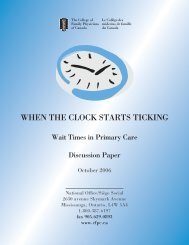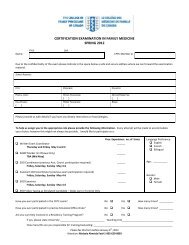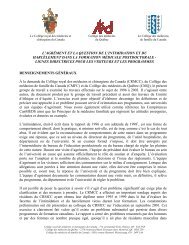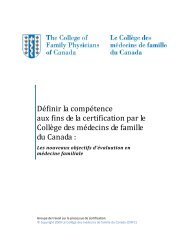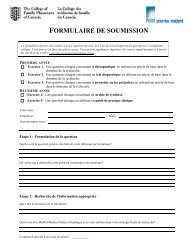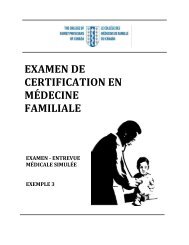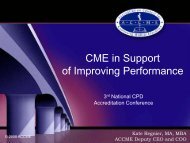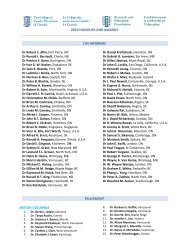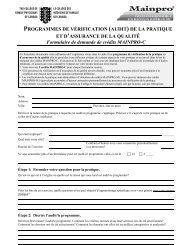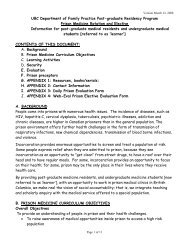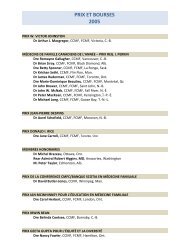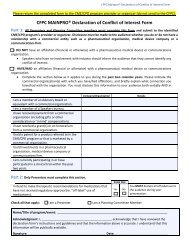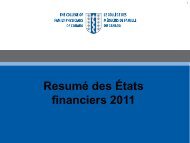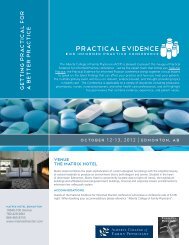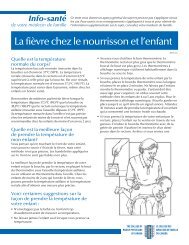The Red Book - The College of Family Physicians Canada
The Red Book - The College of Family Physicians Canada
The Red Book - The College of Family Physicians Canada
- No tags were found...
Create successful ePaper yourself
Turn your PDF publications into a flip-book with our unique Google optimized e-Paper software.
Table <strong>of</strong> ContentsOverview <strong>of</strong> the Accreditation Process ............................................................................... 3Organization <strong>of</strong> the Process ................................................................................................ 4Introduction to <strong>The</strong> <strong>Red</strong> <strong>Book</strong>: <strong>Family</strong> Medicine ................................................................. 6Specific Standards for <strong>Family</strong> Medicine Residency Programs Accredited by the CFPC ....... 7Standard B.1: Administrative Structure and Supports........................................................ 7Standard B.2: Goals and Objectives .................................................................................. 11Standard B.3: <strong>The</strong> Learning Environment ........................................................................ 12Standard B.4: Resources .................................................................................................. 13Standard B.5: Clinical, Academic, and Scholarly Content <strong>of</strong> the Program......................... 17Standard B.6: Assessment <strong>of</strong> Resident Performance ......................................................... 23Enhanced Skills: Specific Standards for <strong>Family</strong> Medicine Enhanced-Skills ResidencyPrograms Accredited by the CFPC ................................................................................... 26<strong>Family</strong> Medicine/Emergency Medicine: Standards for the Accreditation <strong>of</strong> <strong>Family</strong>Medicine/Emergency Medicine Residency Programs ........................................................ 29Care <strong>of</strong> the Elderly: Standards for Programs in Care <strong>of</strong> the Elderly................................... 36<strong>Family</strong> Practice–Anesthesia: Standards for the Accreditation <strong>of</strong> <strong>Family</strong> Practice–Anesthesia Training Programs ......................................................................................... 40Clinician Scholar Program: Standards for the Accreditation <strong>of</strong> the Clinician ScholarProgram ........................................................................................................................... 49Palliative Medicine: Specific Standards <strong>of</strong> Accreditation for a One-Year Program <strong>of</strong> AddedCompetence in Palliative Medicine ................................................................................... 52Categories <strong>of</strong> Accreditation .............................................................................................. 64Guidelines for an Appeal <strong>of</strong> an Accreditation Decision ..................................................... 67Procedure for Imposition <strong>of</strong> Adverse Actions ................................................................... 682
Responses from the university intended to correct identified deficiencies can becommunicated to the committee but will not directly influence the accreditation decision.Information about changes or projected changes could influence the nature <strong>of</strong> the follow-up.<strong>The</strong> <strong>College</strong> has in place an appeal process, which a training program can use in the case <strong>of</strong> anadverse decision. Details <strong>of</strong> this appeal process are provided at the end <strong>of</strong> this document.5
INTRODUCTION TO THE RED BOOK: FAMILY MEDICINE<strong>The</strong> general standards for the accreditation <strong>of</strong> postgraduate training programs commonly knownas the “B standards” define the standards common to all postgraduate medical training in<strong>Canada</strong> and are agreed to by the three postgraduate medical education accrediting agencies: the<strong>College</strong> <strong>of</strong> <strong>Family</strong> <strong>Physicians</strong> <strong>of</strong> <strong>Canada</strong> (CFPC), the Royal <strong>College</strong> <strong>of</strong> <strong>Physicians</strong> and Surgeons<strong>of</strong> <strong>Canada</strong> (RCPSC), and the Collège des médecins du Québec (CMQ). <strong>The</strong>se disciplinespecificstandards for family medicine are complementary to and consistent with the B standardsand will clarify or expand on the B standards as they relate to the education <strong>of</strong> family physicians.<strong>The</strong> standards by which programs will be evaluated are a combination <strong>of</strong> the general standardsand those outlined in this document.6
SPECIFIC STANDARDS FOR FAMILY MEDICINE RESIDENCY PROGRAMSACCREDITED BY THE CFPCSTANDARD B.1: ADMINISTRATIVE STRUCTURE AND SUPPORTSA residency program must be based in an academic department <strong>of</strong> family medicine within auniversity faculty <strong>of</strong> medicine and have an administrative structure that enables the centralprogram to govern all the various distributed residency training sites in an efficient and equitableway. <strong>The</strong> following general guidelines will apply to all residency programs under the direction <strong>of</strong>university departments <strong>of</strong> family medicine. A minimum <strong>of</strong> 24 months <strong>of</strong> training is required tocomplete the program.Postgraduate Program Director1. <strong>The</strong> postgraduate program director must hold certification in family medicine and be ingood standing with the <strong>College</strong> <strong>of</strong> <strong>Family</strong> <strong>Physicians</strong> <strong>of</strong> <strong>Canada</strong> (CFPC) or with the Collègedes médecins du Québec (CMQ). <strong>The</strong> postgraduate program director is responsible for all<strong>of</strong> the postgraduate educational activities <strong>of</strong> the university department <strong>of</strong> family medicine,including the residency program in family medicine and any enhanced skills programs thatmight be administered under the governance <strong>of</strong> the department <strong>of</strong> family medicine.2. <strong>The</strong> postgraduate program director must be assured <strong>of</strong> sufficient time and support tosupervise and administer the program. He or she is responsible to the head <strong>of</strong> thedepartment concerned and to the postgraduate dean <strong>of</strong> the faculty <strong>of</strong> medicine. <strong>The</strong> <strong>College</strong>must be informed by the university postgraduate <strong>of</strong>fice when a new postgraduate programdirector is appointed.Postgraduate Program Director and the Residency Program Committee3. <strong>The</strong>re must be a residency program committee to assist the postgraduate program directorin the planning, implementation, organization, supervision, and evaluation <strong>of</strong> all thepostgraduate family medicine programs.4. <strong>The</strong> responsibilities <strong>of</strong> the postgraduate director, assisted by the residency programcommittee, include the following:a) Developing and operating the program such that it meets the general and specificstandards <strong>of</strong> accreditation as set forth in this document7
) Designing and implementing learning opportunities for residents to attain allcompetencies as outlined by the CFPCc) Selecting candidates for admission to the programd) Overseeing the assessment system to determine competence <strong>of</strong> the residents in theprogram in accordance with policies determined by the faculty, postgraduate medicaleducation committee, and the CFPCe) Ensuring that residents are involved in the governance <strong>of</strong> the department and in theresidency program, including the election <strong>of</strong> the chief resident, resident involvement inprogram committees, and resident involvement in program planning and evaluationf) Maintaining an appeal mechanism. <strong>The</strong> residency program committee should receiveand review appeals from residents and, where appropriate, refer the matter to thefaculty postgraduate medical education committee or faculty appeal committeeg) Establishing mechanisms to provide career planning and counseling for residentsh) Instituting mechanisms to deal with problems such as those related to resident healthand well-being, including stress, intimidation, or harassmenti) Creating a written policy governing resident safety related to travel and patientencounters, including house calls, after-hours consultations in isolated settings, andpatient transfers (eg, Medevac). <strong>The</strong> policy should allow residents discretion andjudgment regarding their personal safety and ensure residents are appropriatelysupervised during all such clinical encounters. <strong>The</strong> policy must specifically includeeducational activities (eg, identifying risk indicators).Special accommodation must be provided to residents with physical/healthchallenges in accordance with university policies.j) Ensuring that there is an identified faculty member with the responsibility to facilitateand supervise the involvement <strong>of</strong> residents in research and other scholarly workk) Maintaining a link with the undergraduate program in order to demonstrate continuity<strong>of</strong> educationTraining Sites5. <strong>The</strong>re must be a site coordinator at each geographic site or program stream—includingsites <strong>of</strong>fering electives—who is responsible to the postgraduate program director and/or8
enhanced skills program coordinator. An active liaison between the postgraduate programdirector and the site coordinators must be maintained.Program Evaluation<strong>The</strong> academic department must maintain an ongoing review <strong>of</strong> the residency training programto evaluate the quality <strong>of</strong> the educational experience and to review the resources available inorder to ensure that maximal benefit is being derived from the integration <strong>of</strong> the components <strong>of</strong>the program. <strong>The</strong> opinions <strong>of</strong> the residents must be among the factors considered in this review.Appropriate faculty/resident interaction and communication must take place in an open andcollegial atmosphere so that a free discussion <strong>of</strong> the strengths and weaknesses <strong>of</strong> the program canoccur without hindrance. An important aspect <strong>of</strong> a successful competency-based educationalprogram is the program’s commitment and ability to monitor itself for quality, particularly withrespect to the learners’ educational outcomes, and to make the necessary curricularmodifications that will result in improved outcomes. This review must be conducted in amanner that respects confidentiality and must include the following:a) An evaluation <strong>of</strong> each component <strong>of</strong> the program to ensure that the educationalobjectives are being metb) An evaluation <strong>of</strong> resource allocation to ensure that resources and facilities are beingutilized with optimal effectivenessc) An evaluation <strong>of</strong> the teachers in the programd) An evaluation <strong>of</strong> the outcomes <strong>of</strong> the residency programs, including, but not limited to:(i) Measurements <strong>of</strong> resident performance, including degree <strong>of</strong> variation acrosstraining sites(ii) Feedback from recent graduates who are able to reflect on their training havingacquired a perspective on the requirements <strong>of</strong> clinical practicePostgraduate Resident Assessment CoordinatorEach program should identify a person or persons who will have the responsibility <strong>of</strong>coordinating resident assessment. <strong>The</strong> role <strong>of</strong> resident assessment coordinator could be theresponsibility <strong>of</strong> a single person or <strong>of</strong> a committee. <strong>The</strong> resident assessment coordinator shouldbe a member <strong>of</strong> the residency postgraduate committee.9
<strong>The</strong> responsibilities <strong>of</strong> this individual or committee should include the following:a) Working with the postgraduate committee to make recommendations for overallresident assessment policyb) Coordinating the distribution <strong>of</strong> resident assessment forms and the collection andcollation <strong>of</strong> datac) Identifying those areas pertaining to assessment that would benefit from facultydevelopmentd) Providing a resource for reviewing and improving the process <strong>of</strong> resident assessmente) Maintaining effective liaison with other specialty placements to communicate aboutobjectives and resident assessmentf) Participating in the process <strong>of</strong> identifying residents who are having problems in thetraining programg) Furnishing feedback to preceptors about the quality <strong>of</strong> their assessments <strong>of</strong> theresidents assigned to them. <strong>The</strong>se responsibilities could be shared among a number <strong>of</strong>individuals, including a program committee for resident assessmentFaculty AdvisorEach resident must have a faculty advisor. In many cases the role <strong>of</strong> Preceptor is merged withthat <strong>of</strong> Advisor, but all residents should have the option <strong>of</strong> having an advisor who is not directlyresponsible for assessing that resident.<strong>The</strong> role <strong>of</strong> the faculty advisor is to:a) Orient the resident to the discipline <strong>of</strong> family medicineb) Discuss with the resident the program objectives and the resident’s own learningobjectives, and design an appropriate educational planc) Review this plan regularly and assist the resident in finding the resources within theprogram necessary to meet his or her unique learning needsd) Help the resident to:(i) Reflect on program choices to be made(ii) Understand assessment feedback(iii) Set and revise learning objectives(iv) Define career plans10
STANDARD B.2: GOALS AND OBJECTIVES<strong>The</strong> goals <strong>of</strong> the residency program and the competencies to be acquired by residents must beclearly worded.1. Clearly defined competency-based curriculum outcomes that reflect the six essential skilldimensions <strong>of</strong> competence and the CanMEDS–<strong>Family</strong> Medicine (CanMEDS-FM) rolesmust be in place and must be consistent with the CFPC Triple C Curriculum.2. <strong>The</strong> specific educational outcomes and competencies that are to be achieved in eacheducational experience must be defined.3. All residents must receive a copy <strong>of</strong> the curriculum goals and the desired learnercompetency outcomes on beginning the program. All faculty in the program must alsoreceive a copy.4. <strong>The</strong> statement <strong>of</strong> goals and competency outcomes must be reviewed at least every two yearsby the postgraduate program director and the residency program committee to determinethe continued appropriateness <strong>of</strong> the goals and to ensure they are reflected in theorganization <strong>of</strong> the program and the assessment <strong>of</strong> the residents.11
STANDARD B.3: THE LEARNING ENVIRONMENT<strong>The</strong>re must be an organized program <strong>of</strong> educational experiences, both mandatory and elective,designed to provide each resident with the opportunity to fulfill the educational requirementsand achieve the competencies defined by the program.1. <strong>The</strong> program must be organized such that residents are given increasing pr<strong>of</strong>essionalresponsibility, under appropriate supervision, according to their level <strong>of</strong> training,ability/competence, and experience.2. Service responsibilities, including educational experiences provided by other clinical servicesor departments, must be assigned in a manner that ensures residents are able to attain theireducational objectives, recognizing that many objectives can be met only by the directprovision <strong>of</strong> patient care.Service demands must not interfere with the ability <strong>of</strong> the residents to follow theacademic program.3. <strong>The</strong> program must provide an equivalent opportunity for each resident to take advantage <strong>of</strong>those elements <strong>of</strong> the program best able to meet his or her educational needs.4. <strong>The</strong> program should provide an adequate opportunity for residents to pursue electiveeducational experiences.5. <strong>The</strong> program must provide a learning environment that is safe and supportive <strong>of</strong> itsresidents. Faculty/resident interaction and communication must occur in an open andcollegial atmosphere, such that the tenets <strong>of</strong> acceptable pr<strong>of</strong>essional behaviour and theassurance <strong>of</strong> dignity in the learning environment are maintained at all times.Discussion about the strengths and weaknesses <strong>of</strong> a program must occur freely and in amanner that is without repercussions to residents. An accessible and non-threateningmechanism must be in place to ensure that allegations <strong>of</strong> unpr<strong>of</strong>essional behaviour hindering thelearning environment can be investigated impartially. Program directors, faculty, other teachers,and residents must be educated about appropriate behaviour in the learning environment andspecifically, against intimidation and other abusive behaviour.12
STANDARD B.4: RESOURCES<strong>The</strong>re must be sufficient resources, including teaching faculty, the number and variety <strong>of</strong>patients, physical and technical resources, and the supporting facilities and services necessary, toprovide the opportunity for all residents in the program to achieve the defined competencies.Clinical Teaching Sites1. <strong>The</strong> overall educational experience must provide an adequate patient volume and variety toallow residents an opportunity to experience all aspects <strong>of</strong> family practice, includingintrapartum care. Teaching practices must allow a resident to acquire the identity <strong>of</strong> afamily physician. <strong>The</strong>re must be an opportunity for continuity <strong>of</strong> care to allow residents toobserve the natural progression <strong>of</strong> disease, as well as a requirement that residents beavailable to and responsible for a group <strong>of</strong> patients over time. <strong>The</strong> practice must beorganized in such a manner that residents can build and maintain a defined panel <strong>of</strong>patients. Resident responsibility should be such that patients recognize the resident as one<strong>of</strong> their personal physicians and that residents are directly responsible for the delivery <strong>of</strong>care to those patients with whom they are identified.2. Clinical services and other resources used for teaching must be organized to achieve thedesired competencies.a) Teaching staff must exercise the double responsibility <strong>of</strong> providing high-quality, ethicalpatient care and excellent teaching. Staff members who fail to meet these obligations, asjudged by the internal evaluation procedures <strong>of</strong> the faculty, should be relieved <strong>of</strong>teaching duties.b) Learning experiences that demonstrate how practices respond to population healthneeds must be <strong>of</strong>fered.c) <strong>The</strong>re must be an experience-based learning process that provides training incollaboration with other physicians, particularly in the referral/consultation processand shared models <strong>of</strong> care.d) A portion <strong>of</strong> each resident's training should take place in sites involving practitionersfrom other health pr<strong>of</strong>essions in order to facilitate acquisition <strong>of</strong> the competenciesnecessary for good interpr<strong>of</strong>essional collaboration.13
3. <strong>The</strong>re must be ready access to a university-level collection <strong>of</strong> medical texts, journals, andpoint-<strong>of</strong>-care resources, as well as access to instruction in the use <strong>of</strong> these resources. <strong>The</strong>remust be appropriate access to and instruction in hardware and s<strong>of</strong>tware for informationmanagement. Residents must also learn to function in clinical settings where such resourcesare not routinely available. <strong>The</strong> required skills include resource selection and mechanismsfor access (eg, technology vs books) at the point <strong>of</strong> care to support the delivery <strong>of</strong> highqualitypatient care.Faculty4. All family physician teachers who have a major responsibility in the teaching andassessment <strong>of</strong> residents must hold Certification in <strong>Family</strong> Medicine (CCFP) or hold aspecialist certificate in family medicine from the CMQ, and hold academic appointments inthe university’s department <strong>of</strong> family medicine.This does not preclude the appointment <strong>of</strong> family physicians with other or equivalentqualifications. However, any family physician teacher who has an important responsibilityin the teaching and assessment <strong>of</strong> residents who is appointed to a university department <strong>of</strong>family medicine but who does not hold certification in family medicine with the CFPCshould seek certification within four years <strong>of</strong> appointment.Faculty Evaluation5. Programs must have in place a formal and fair mechanism to evaluate faculty that mustfollow defined and published criteria. This process must have in place a mechanism forobtaining resident comments and other objective criteria related to such areas as teaching,clinical work, and scholarly activity. Faculty evaluation should not be conducted solely forpromotion or disciplinary purposes; rather, it should be done regularly and in a formativemanner, and should encourage the faculty member to perform self-evaluations and setobjectives for his or her own development.Faculty Development6. a) Faculty should be knowledgeable about the principles and theories <strong>of</strong> teaching andlearning, and other appropriate educational theory and techniques. This must beensured through an effective program <strong>of</strong> faculty development.14
) Program directors, faculty, other teachers, and residents should be educated aboutappropriate behaviour in the learning environment and about intimidation and otherabusive behaviour.c) Each department <strong>of</strong> family medicine must plan and implement faculty developmentactivities for its teachers.(i) Faculty development should be appropriate to the departmental context. That is,faculty development activities should be planned according to the department’smission, goals, and objectives.(ii) Available resources in the larger university setting should also be considered inprogram planning.(iii) Faculty development should be faculty centred. Faculty development should bebased on the needs <strong>of</strong> individual full-time and part-time teachers, and shouldencourage a commitment to their self-directed and lifelong learning.(iv) Faculty development programming should include a variety <strong>of</strong> content areas,teaching methods, and activities in order to meet diverse departmental needs, andshould be evaluated on an ongoing basis.(v) Faculty development should be actively supported and promoted. Eachdepartment should allocate human and financial resources to faculty developmentprogramming in order to ensure its success. Moreover, each department shoulddevelop an appropriate administrative structure to oversee the development andimplementation <strong>of</strong> faculty development programming, and should collaborate withkey players in the university and other pr<strong>of</strong>essional organizations to ensure thatappropriate faculty development opportunities are available.15
Scholarly Activity7. A satisfactory level <strong>of</strong> research and scholarly activity must be maintained among thedepartmental faculty identified with the program, as evidenced by the following:a) Peer-reviewed research fundingb) Publication <strong>of</strong> original research in peer-reviewed journals and/or publication <strong>of</strong> reviewarticles, etc.c) Involvement by faculty and residents in current research projectsd) Recognized innovation in medical education, clinical care, or medical administration16
STANDARD B.5: CLINICAL, ACADEMIC, AND SCHOLARLY CONTENT OFTHE PROGRAM<strong>The</strong> goal <strong>of</strong> the residency program is to develop family physicians who are competent to beginthe independent practice <strong>of</strong> comprehensive family medicine anywhere in <strong>Canada</strong>. Residencyeducation must provide both the clinical and academic/scholarly content to enable learners toachieve this level <strong>of</strong> competence. <strong>The</strong> CFPC has provided resources to assist programs indesigning curricula that reflect a competency-based approach to family medicine education. <strong>The</strong>following documents provide programs with a guide to the competencies that must be acquired,and with the clinical and academic experiences that enable residents to acquire them:1. <strong>The</strong> CanMEDS-FM Competency Framework2. Defining competence for the purposes <strong>of</strong> certification by the <strong>College</strong> <strong>of</strong> <strong>Family</strong> <strong>Physicians</strong><strong>of</strong> <strong>Canada</strong>: <strong>The</strong> evaluation objectives in family medicine3. <strong>The</strong> Scope <strong>of</strong> Training for <strong>Family</strong> Medicine Residency Domains <strong>of</strong> Clinical Care andEvolving Pr<strong>of</strong>essional Competencies4. <strong>The</strong> Triple C Curriculum<strong>The</strong> Clinical Context for Learning<strong>Family</strong> medicine residency training programs must model comprehensive care that is centred infamily medicine and must train residents to this standard. <strong>The</strong> focus must be on comprehensivefamily practice, with the provision <strong>of</strong> continuing care to an identified group <strong>of</strong> patients.Continuity is an important principle in family medicine education: continuity <strong>of</strong> patientand family care, continuity in the educational environment, and continuity <strong>of</strong> instruction andteachers.<strong>The</strong> curriculum should be flexible to allow residents to develop the special skills they willneed to practise in widely varied settings. As previously noted, training should occur primarily infamily practice settings taught and supervised by family medicine faculty. Other medicalspecialty services <strong>of</strong>fer unique clinical resources that can be used to facilitate and enhance thefamily practice experience. Such experiences need not be provided as blocks <strong>of</strong> time but can andshould be integrated as much as possible into the family medicine context <strong>of</strong> learning. <strong>The</strong>seexperiences should reflect the clinical domains that describe the comprehensive nature <strong>of</strong> familymedicine and include work in ambulatory and inpatient services or day hospitals, emergency17
services, community services or seminars with marginalized populations, and scholarly work. Ifresidents are not taught by family medicine faculty, they should be placed in a clinical context inwhich the preceptors understand and respect the role and the educational needs <strong>of</strong> familymedicine learners. <strong>The</strong> family medicine residency program must plan and approve theseexperiences in consultation with the other specialty departments involved.<strong>Family</strong> medicine residency training must occur in clinical settings that enable residents tolearn the competencies required. <strong>The</strong> experiences arising from time immersed in family practicesettings are vital to the development <strong>of</strong> a resident’s overall competence and identity as a familyphysician. <strong>Family</strong> practice settings must provide residents with the opportunity to experienceboth the roles <strong>of</strong> the family physician and the scope <strong>of</strong> family practice. Residents must be able toestablish a small practice <strong>of</strong> their own for which they would assume major responsibility forintegrating the full care <strong>of</strong> those patients with whom they have continuing relationships. <strong>Family</strong>practice experiences should be organized to reflect appropriate patterns <strong>of</strong> practice, and residentsmust work together with and be supervised by effective family physician role models. It isexpected that residents will be engaged in core family medicine clinical experiences throughouttheir training program.While the curriculum must always provide for a sufficient continuity <strong>of</strong> learning contextand continuity <strong>of</strong> preceptors, sufficient exposure to different contexts <strong>of</strong> practice that reflectdifferent population health needs must also be provided.Just as practising family physicians work largely in <strong>of</strong>fice settings, so residents must bebased primarily in family practice <strong>of</strong>fice settings. Residents must provide clinical care acrossdifferent settings: hospital, long-term care facilities, and home care settings, as well as in the<strong>of</strong>fice. Residents must provide care to patients at every stage <strong>of</strong> life, from birth to death. Thisincludes care <strong>of</strong> children and adults, men and women, the elderly, and palliation and end-<strong>of</strong>-lifecare. A sufficient clinical experience in a rural practice setting must be provided to all residentsto ensure that the competencies and experience necessary to serving the needs <strong>of</strong> ruralcommunities are acquired.In order to learn the comprehensive nature <strong>of</strong> family medicine, family practice–basedpatient care activities must comprise the majority <strong>of</strong> the resident’s clinical experience. Ideally, aresident’s family practice experience would make up more than half <strong>of</strong> a resident’s clinicalexperience each week, with the exception <strong>of</strong> <strong>of</strong>f-service experiences that might require more18
intensive exposure to meet defined competencies. In addition to actual <strong>of</strong>fice-based patientcontacts, this practice-centred experience can include weekend clinics or rounds, hospital visitsto patients admitted through the practice, and other patient care activities directly related to thepatients <strong>of</strong> the practice. Residents must maintain continuing responsibility for their patients invarious settings—such as hospital, home, and long-term care institutions. Residents must beinvolved in providing after-hours care as part <strong>of</strong> their patient care responsibilities during theircore family practice experiences. Residents must learn to communicate verbally and in writingwith other health care pr<strong>of</strong>essionals about their patients, including other specialists, and mustlearn how to follow up on their referrals.<strong>The</strong> overall practice-based experience should provide a reasonable balance <strong>of</strong> acute andchronic care, ambulatory care, and hospital care. It should also provide a breadth <strong>of</strong> involvementwith patients from all age groups and in a sufficient variety <strong>of</strong> clinical domains, includingobstetrical patients.<strong>The</strong>re must be a progression <strong>of</strong> responsibility and activities as a resident advances throughthe program, ultimately approaching the level <strong>of</strong> function expected <strong>of</strong> a practising familyphysician. <strong>The</strong>refore, within the context <strong>of</strong> learning defined above, residents must haveappropriate exposure to the following domains <strong>of</strong> care.Emergency care:Residents must be exposed to acute care settings and be provided with an opportunity to learnthe skills required for emergency diagnosis and care.Care <strong>of</strong> children and adolescents:Residents must have exposure to a volume <strong>of</strong> pediatric patients that will allow them to studychildren’s normal growth and development and to learn the diagnosis and management <strong>of</strong>common pediatric and adolescent problems that present in the family practice setting. Trainingin neonatal resuscitation must be provided.Maternity care (antepartum, intrapartum, postpartum):<strong>The</strong> resident must gain confidence and competence in maternity care by following pregnantpatients and conducting deliveries with family physician role models. Competencies include the19
common procedures during labour and delivery that permit the resident to complete low-riskdeliveries independently. Residents must be competent in managing obstetrical emergencies.Care <strong>of</strong> the elderly:Residents must be able to provide comprehensive care for the elderly. <strong>The</strong>y must also befamiliar with the atypical presentation <strong>of</strong> illness in this unique population and with themanagement <strong>of</strong> common geriatric and psychogeriatric problems—both physical andpsychological—in hospital, institution, and community settings such as the patient’s home.Care <strong>of</strong> Aboriginal populations:Residents must develop the skills to work with and provide appropriate care for aboriginalpopulations.Palliative medicine (end-<strong>of</strong>-life care):Residents must gain the competencies to provide care for patients and their families in the homeand in institutions at the end <strong>of</strong> life. Residents should acquire competencies in collaborativemodels that assist with patient management.Care <strong>of</strong> marginalized or disadvantaged or underserviced populations:Residents must develop the skills to work with and provide appropriate care for a variety <strong>of</strong>marginalized or disadvantaged populations (ie, inner-city, the poor, the homeless, recentimmigrants, etc.).Behavioural medicine (mental health care):Residents must be involved in the delivery <strong>of</strong> collaborative mental health care. Programs mustprovide appropriate experiences for residents in crisis management dealing with acutepsychiatric illness, and the management <strong>of</strong> patients and families with behavioural and emotionaldifficulties.20
<strong>The</strong> Academic Program<strong>The</strong>re must be a well-organized and comprehensive academic program that complements theclinical learning activities <strong>of</strong> the residents. It should engage residents in the delivery <strong>of</strong> thecontent to enhance their teaching and learning skills, including the development <strong>of</strong> skills asautonomous learners. It must make use <strong>of</strong> a variety <strong>of</strong> teaching methods and take into accountthe range <strong>of</strong> learning styles among the resident group.<strong>The</strong> academic program must be coordinated through the residency program committeeand be delivered in a consistent manner to all residents at all sites.While acknowledging that different sites will have different resources to support theprogram, an effort must be made to ensure that the governing goals <strong>of</strong> the program areaddressed in all sites and are adapted to the clinical and teaching resources available at each site.Scholarly Activity<strong>The</strong> academic program must include organized activities that stimulate and reinforce relevantenquiry (eg, journal clubs, seminars or didactic sessions.) Key concepts in biostatistics, criticalappraisal, and biomedical ethics must be taught, and their application to practice must bepromoted. This academic program should be designed to supplement and enhance theexperiential learning <strong>of</strong>fered to residents in both their family practice and other clinically basedor educational experiences.<strong>The</strong> quality <strong>of</strong> scholarship in the program should, in part, be demonstrated by a spirit <strong>of</strong>enquiry during clinical discussions, experiences outside <strong>of</strong> family medicine, and conferences.Scholarship implies an in-depth understanding <strong>of</strong> basic mechanisms <strong>of</strong> normal and abnormalstates, and the application <strong>of</strong> current knowledge to practice.<strong>The</strong> demands <strong>of</strong> clinical learning must not interfere significantly with residents' ability toparticipate in the academic program. Attendance at key academic activities must be assured byfreeing residents from other duties.<strong>The</strong>re must be easy access to biomedical information resources in print or electronic form,including textbooks, journals, and indexes, at the level <strong>of</strong> a university or major hospital librarycollection. <strong>The</strong>re must be easy access to core biomedical information resources during eveningsand weekends.21
Residents must be given opportunities to develop effective teaching skills throughorganized activities focused on teaching techniques. Residents should have opportunities toteach and to become role models to junior residents and medical students.A satisfactory level <strong>of</strong> scholarly activity must be maintained within the program byactivities such as:1. A funded research program2. Publications, including articles in peer-reviewed journals, books, and curriculum materials,etc.3. Residents' involvement in research projects4. Participation in relevant committees, including research committees, research ethics boards,etc.5. A faculty member whose responsibility it is to facilitate residents' involvement in researchand other scholarly activity, such as resident projects22
STANDARD B.6: ASSESSMENT OF RESIDENT PERFORMANCE<strong>The</strong>re must be an effective in-training assessment program in place that helps the resident, thepreceptors, and the program plan, and that monitors the progress <strong>of</strong> individual residentsthroughout their training towards the achievement <strong>of</strong> the competence expected for the start <strong>of</strong>independent practice. This competence is defined as demonstrating competence in the sixessential skill dimensions and the phases <strong>of</strong> the clinical encounter, throughout the sevenCanMEDS-FM roles, over a sufficient sample <strong>of</strong> the priority topics, themes, core procedures,and competencies, as defined by the evaluation objectives and CanMEDS-FM.General Considerations1. <strong>The</strong> in-training assessment system must be competency-based and mainly formative innature, with honest, helpful, and timely feedback provided to each resident. It should not bepunitive. Emphasis should be placed on gradually achieving mastery in the requiredcompetencies. Assessment and feedback must lead to guided self-assessment, reflection, andrevision <strong>of</strong> learning plans as necessary.2. Assessment and feedback must not be limited to the end <strong>of</strong> an activity or a clinicalexperience. <strong>The</strong>y must occur frequently, at least by the middle <strong>of</strong> a placement, in time forbehaviour change to occur, and, ideally, on a daily basis or immediately after an activity,whenever pertinent. Periodic reviews and summative assessments based on all thedocumented assessments available at the time must be completed. <strong>The</strong>se must include faceto-facemeetings with the resident to review and discuss their progress, both regularly andwhen a specific need arises.3. Assessment and feedback must be documented and reflect resident performance withrespect to the competencies in question. Although both qualitative and quantitative datashould be documented, the emphasis should be on the former.4. All pertinent activities, both clinical and non-clinical, should be assessed, and theassessment should be specific to the activities, clearly reflecting the competency objectives <strong>of</strong>family medicine. <strong>The</strong> level <strong>of</strong> performance expected for each activity should be clearlydefined and clearly understood by both the resident and the preceptor-assessor. <strong>The</strong>methods to be used for assessment must also be clearly defined and mutually understood.23
5. Assessment processes are more effective when based on individual resident learning plans orcontracts. Programs should develop and regularly review a written plan with each residentthat addresses both the educational objectives <strong>of</strong> the training program and the specificlearning needs and goals <strong>of</strong> each resident.6. <strong>The</strong> assessment system should permit very early identification (ie, well before anysummative assessment) or self-identification <strong>of</strong> residents who are not progressing asexpected. <strong>The</strong>ir training, supervision, and assessment should be modified appropriately andthey should be considered separately until the difficulties are resolved.7. Residents must be informed when serious concerns exist and must be given an opportunityto correct their performance.Specific Considerations1. Assessment must place emphasis on situations and patients with problems that correspondto the range and variety <strong>of</strong> family medicine practice. It must also concentrate on thecompetencies most important to family medicine as described by the Evaluation Objectivesand CanMEDS-FM.2. Methods <strong>of</strong> assessment and documentation:a) <strong>The</strong> principal instrument for assessment should be the preceptor-resident unit. Thisunit should assess a single patient interaction or other clinical or para-clinical situationand document the assessment appropriately. Direct observation is a fundamental tool;however, case discussion and record review are also important for clinical assessments.Assessment <strong>of</strong> non-clinical activities is important and requires other methods <strong>of</strong>documentation.b) Other performance assessments <strong>of</strong> various kinds should also be used whereappropriate, and must be added for residents deemed to be “not progressing asexpected.”c) Field notes and daily assessments:(i) Programs should use field notes (or equivalent) to gather qualitative comments onresident performance during daily clinical practice and should integrate them intotheir regular teaching and supervision. <strong>The</strong>y should generate a sufficient number24
<strong>of</strong> field notes to provide and document meaningful, formative assessment andfeedback.(ii) Comments on clinical supervision or other activities should be case specific; focuson the one, most significant aspect <strong>of</strong> the case; lead to reflection and feedback; andprovide recommendations for future similar cases (change or no change). This“daily” feedback should not make final judgments on overall competence, readinessto practice, or readiness to progress; rather, it is meant to contribute on a moremicro level to summative assessments.(iii) Field notes can be compiled in a portfolio to be added to all other pertinentinformation for consideration when completing periodic summative assessments.Summative Reports and Decisions on Progress1. Summative reports and decisions on progress must be completed on a regular,predetermined basis. <strong>The</strong>y must be based on multiple independently documentedobservations from several observers in different situations, and be compiled and judged bymore than one clinical faculty.2. Periodic summative reports, including the final one to the <strong>College</strong>, should reflect thecurrent level <strong>of</strong> competence achieved by the resident and should not reflect past difficultiesthat have been dealt with satisfactorily.Confirmation <strong>of</strong> Completion <strong>of</strong> Training<strong>The</strong> program will be asked to attest to the <strong>College</strong> that:<strong>The</strong> resident has demonstrated competence in the six essential skill dimensions and thephases <strong>of</strong> the clinical encounter, throughout the seven CanMEDS-FM roles, over asufficient sample <strong>of</strong> the priority topics, themes, core procedures, and competencies, asdefined by the evaluation objectives and CanMEDS-FM and we therefore judge theresident competent to start the independent practice <strong>of</strong> family medicine.25
ENHANCED SKILLS: SPECIFIC STANDARDS FOR FAMILY MEDICINEENHANCED-SKILLS RESIDENCY PROGRAMS ACCREDITED BY THE CFPC<strong>The</strong>se discipline-specific standards for overarching enhanced skills programs are complementaryto and consistent with the family medicine–specific standards and will clarify or expand on theB standards as they relate to the education <strong>of</strong> family physicians.Introduction<strong>The</strong> CFPC recognizes and accredits training in a variety <strong>of</strong> areas <strong>of</strong> enhanced skills within familymedicine. This training normally occurs following completion <strong>of</strong> the residency training programin family medicine and could extend for a few months or a full year. <strong>The</strong> purpose <strong>of</strong> thesetraining programs is to provide residents with additional competencies they will require in theirfuture practice. In some cases these programs will be tailored specifically to the needs <strong>of</strong>individual residents (Category 2 programs) but in some defined areas the <strong>College</strong> has establishednational standards for curriculum and training (Category 1 programs).Current Category One Programs<strong>The</strong> currently recognized Category One programs (with national standards) are as follows:• Emergency Medicine• Care <strong>of</strong> the Elderly• <strong>Family</strong> Practice Anesthesia• Clinician Scholar• Palliative MedicineCategory Two programs include but are not limited to the following:• Maternity Care• Women’s Health• Chronic DiseaseIn order to be eligible for accreditation the programs must be administered directly by thepostgraduate <strong>of</strong>fice <strong>of</strong> the department <strong>of</strong> family medicine. <strong>The</strong> programs must also comply withthe general accreditation standards applicable to all residency programs, commonly known as26
committee for the enhanced skills program with defined terms <strong>of</strong> reference that will meetregularly to provide oversight for the program.Resources<strong>The</strong> department <strong>of</strong> family medicine must provide the necessary resources to ensure the effectiveadministration <strong>of</strong> the educational programs under its jurisdiction.28
FAMILY MEDICINE/EMERGENCY MEDICINE: STANDARDS FOR THEACCREDITATION OF FAMILY MEDICINE/EMERGENCY MEDICINERESIDENCY PROGRAMS<strong>The</strong>se discipline-specific standards for family medicine/emergency medicine programs arecomplementary to and consistent with the family medicine–specific standards and will clarify orexpand on the B standards as they relate to the education <strong>of</strong> family physicians.IntroductionAll family physicians must be trained to deal with emergency medical conditions. <strong>The</strong>development <strong>of</strong> postgraduate training programs in emergency medicine will provide familyphysicians the opportunity to bring enhanced skills in emergency medicine to theircommunities. To optimize the delivery <strong>of</strong> emergency medical care to the Canadian public, theseprograms must utilize the resources and support <strong>of</strong> appropriate medical and surgical disciplines.<strong>The</strong> principles <strong>of</strong> family medicine and the core cognitive and affective skills <strong>of</strong> the familyphysician must be integrated into these training programs for special competence in emergencymedicine.<strong>The</strong> goals <strong>of</strong> Certification in <strong>Family</strong> Medicine with added competency in EmergencyMedicine [CCFP(EM)] are as follows:1. To improve the standards and availability <strong>of</strong> emergency care from practicing familyphysicians2. To establish guidelines for the development and administration <strong>of</strong> training programs inemergency medicine for family physicians3. To ensure the availability <strong>of</strong> teachers for training programs in family medicine/emergencymedicine.Curriculum<strong>The</strong> program should provide, either within a three-year integrated training program or a oneyeartraining program, a minimum 12-month curriculum in emergency medicine as outlined inthis section. Residents must be certified in family medicine by the CFPC or have successfullycompleted an accredited family medicine training program.29
1. Implement the principles <strong>of</strong> quality assurance, risk management, continuous qualityimprovement, and total quality management. He or she should be able to assume aleadership role in improving services and monitoring the quality <strong>of</strong> care in communitybasedemergency services2. Develop the administrative capacity to serve as a community- and hospital-based resourcefor the practice <strong>of</strong> emergency medicine<strong>The</strong> doctor-patient relationship is central to the role <strong>of</strong> the family physician.<strong>Family</strong> physicians understand and appreciate the human condition, especially the nature <strong>of</strong>suffering and patients’ response to illness. <strong>The</strong>y are aware <strong>of</strong> their strengths and limitations, andrecognize when their own personal issues interfere with effective care.<strong>The</strong>y respect the primacy <strong>of</strong> the person. <strong>The</strong> relationship has the qualities <strong>of</strong> a covenant—a promise, by physicians, to be faithful to their commitment to the well-being <strong>of</strong> patients,whether or not patients are able to follow through on their commitments.<strong>Family</strong> physicians are committed to ensuring continuing care for their patients. <strong>The</strong>y linkto community-based primary care resources.A CCFP(EM) resident must acquire the knowledge and skills to:1. Demonstrate an effective doctor-patient relationship, and apply the patient-centred clinicalmethod in the emergency room setting2. Demonstrate effective communication skills with patients, families, and coworkers3. Make ethical decisions in the emergency department, and identify medico-legal issues asthey pertain to the practice <strong>of</strong> emergency medicine<strong>The</strong> training program must provide:1. An identifiable formal teaching program in emergency medicine. This program mustprovide clinical teaching opportunities, seminars, formal teaching rounds, and otherlearning opportunities necessary to achieve the objectives outlined herein. <strong>The</strong> acquisition<strong>of</strong> critical appraisal skills is essential. Programs might require residents to complete anacademic project. For those residents who wish to pursue an academic project (research,literature review, quality improvement), the program should provide the opportunity to doso.32
2. Opportunities for the resident to interact with various organizations, agencies, and servicesthat deliver emergency medical care to the community.3. Opportunities for the resident to secure appropriate, relevant training experience in otherdisciplines related to emergency medicine, especially to adult critical care medicine.4. A minimum <strong>of</strong> eight months in the emergency department in the combined familymedicine/emergency medicine program, with a minimum <strong>of</strong> six months in the third year.At completion <strong>of</strong> the third year <strong>of</strong> training, the resident will possess the knowledge andskills necessary to develop a leadership role in a community emergency department.5. <strong>The</strong> equivalent <strong>of</strong> at least two months <strong>of</strong> training in emergency and/or critical carepediatrics, which may be part <strong>of</strong> the eight months <strong>of</strong> “emergency” training.6. An educational environment which facilitates and encourages residents to maintain anongoing responsibility in a family practice setting throughout the third year.7. A system <strong>of</strong> evaluation, for both residents and faculty, that is congruent with the principlesoutlined in the B standards.Program Organization<strong>The</strong> CCFP(EM) residency training program must be conducted in cooperation with theuniversity department or division <strong>of</strong> family medicine, and provide a curriculum based on theeducational objectives in emergency medicine <strong>of</strong> the CFPC.<strong>The</strong> program must have access to facilities <strong>of</strong> the faculty <strong>of</strong> medicine, the department <strong>of</strong>family medicine, and participating hospitals.<strong>The</strong> training program must provide a CCFP(EM) program director who holds theCCFP(EM) designation. <strong>The</strong> director must be responsible to the postgraduate director <strong>of</strong> thedepartment <strong>of</strong> family medicine, and must be appointed by that department. <strong>The</strong> residents inemergency medicine are directly responsible to this individual. <strong>The</strong> program director must havethe responsibility and authority to assign residents to the appropriate settings and rotations.<strong>The</strong> CCFP(EM) program director will be assisted by an emergency medicinepostgraduate education committee. <strong>The</strong> committee will include representation from teachingunits, full- and part-time faculty, residents, and allied health pr<strong>of</strong>essionals with appointments inthe department.33
<strong>The</strong> resident representatives on the postgraduate education committee must be selectedby their peers and oriented to their role and responsibilities, both as members <strong>of</strong> the committeeand as resident representatives. This committee should meet at least four times a year.<strong>The</strong> CCFP(EM) program director must be a member <strong>of</strong> the postgraduate educationcommittee <strong>of</strong> the university department <strong>of</strong> family medicine. <strong>The</strong> family medicine postgraduatedirector should be a member <strong>of</strong> the emergency medicine postgraduate committee.Resident SelectionRecognizing that emergency medicine is a part <strong>of</strong> family medicine training and practice,postgraduate directors are reminded that the goal <strong>of</strong> these programs is to provide familyphysicians with enhanced skills training in emergency medicine. As such, these programs areprimarily intended for:1. All recent graduates <strong>of</strong> family medicine training programs2. Any physicians with certification from the CFPC or who is eligible to write the CCFPexamination<strong>The</strong>re must be a selection committee, which should include the family medicine/emergencymedicine program director, a teacher in the program who is in possession <strong>of</strong> a CCFP(EM)certification, and the family medicine postgraduate director or his or her representative.ResourcesClinical teaching resources<strong>The</strong> training program must provide:1. An annual budget sufficient to cover administrative costs and educational resources.2. Emergency medicine teaching units with facilities appropriate for the investigation andtreatment <strong>of</strong> patients. <strong>The</strong> volume and variety <strong>of</strong> work in the institutions participating inthe program must be sufficient to provide an adequate experience over the full range <strong>of</strong>emergency medicine. <strong>The</strong> program must ensure an adequate exposure to the full range <strong>of</strong>age, ethno-cultural, and demographic backgrounds.3. Teaching settings in which family physicians who received certification in family medicinefrom the <strong>College</strong> provide a significant portion <strong>of</strong> the clinical care, and take directresponsibility for the resident’s education and teaching.34
4. Experience during the third year in a community setting where family physicians, as a part<strong>of</strong> their practice pr<strong>of</strong>ile, provide care in the emergency department and in an <strong>of</strong>fice.5. Interdisciplinary experience with social workers, nursing staff, and other healthpr<strong>of</strong>essionals, focusing on their role in the comprehensive delivery <strong>of</strong> health care services inthe emergency department setting.Faculty resources<strong>The</strong> training program must provide:1. Qualified teaching staff in sufficient numbers, some with appointments in the department<strong>of</strong> family medicine, to supervise and teach residents2. Teachers in the family medicine/emergency medicine residency program familiar with thefour principles <strong>of</strong> family medicine as they apply to emergency medicine35
CARE OF THE ELDERLY: STANDARDS FOR PROGRAMS IN CARE OF THEELDERLY<strong>The</strong>se discipline-specific standards for care <strong>of</strong> the elderly programs are complementary to andconsistent with the family medicine–specific standards and will clarify or expand on theB standards as they relate to the education <strong>of</strong> family physicians.Introduction<strong>The</strong> number <strong>of</strong> people and the proportion <strong>of</strong> the population older than age 65 are increasing.Elderly people, particularly those older than age 75 and who are frail or at risk for becoming frailwill require increased medical care by physicians with specific training. <strong>Family</strong> physicians play anincreasingly important role in the primary care <strong>of</strong> the frail elderly in the <strong>of</strong>fice, home, hospital,and nursing home. Others have developed their practice principally in home care or nursinghome programs. Partly because <strong>of</strong> the small number <strong>of</strong> geriatricians, family physicians have alsobecome resource persons in acute care hospitals, nursing homes, and the community, where they<strong>of</strong>ten act as consultants. In academic centres, family physicians are involved in teaching care <strong>of</strong>the elderly in family medicine units or are an integral part <strong>of</strong> geriatric divisions in clinical care,teaching, and research.<strong>The</strong> target populations for this program are those certified in family medicine who are inpractice or coming out <strong>of</strong> residency training and who want to refine and extend their skills andincrease their involvement in the care <strong>of</strong> the elderly in their practice. <strong>The</strong>ir future pr<strong>of</strong>essionalactivities should include the following:1. Primary care geriatric practice2. Being a community resource person in a rural or urban setting3. Program development4. An academic career in family practice health care <strong>of</strong> the elderlyCurriculum<strong>The</strong> training is directed toward care <strong>of</strong> the frail elderly in the context <strong>of</strong> care <strong>of</strong> seniors generally,and toward preventing frailty. <strong>The</strong> following are four broad goals:1. Defining the discipline in terms <strong>of</strong> knowledge and attitudes2. Refining and extending clinical skills appropriate to the discipline36
3. Creating an awareness <strong>of</strong> the services available in the community with utilization <strong>of</strong> a teamapproach4. Creating the skills for community leadership in the development <strong>of</strong> geriatric services andhealth promotion.<strong>The</strong> core objectives for the program must be covered within a six-month period. <strong>The</strong> 12-month program will provide an additional six months <strong>of</strong> training in which residents may meetadditional specific educational objectives in geriatrics. <strong>The</strong> training should be based on the fourprinciples <strong>of</strong> family medicine:<strong>The</strong> doctor-patient relationship is central to the role <strong>of</strong> the family physician.<strong>The</strong> resident must develop and demonstrate appropriate attitudes toward the elderly inproviding care. <strong>The</strong> resident should be familiar with the role <strong>of</strong> and impact on thefamilies/caregiver in the management <strong>of</strong> the elderly, and be able to recognize and manageeffectively the problems <strong>of</strong> the families/caregiver caring for the elderly. <strong>The</strong> resident shoulddemonstrate knowledge <strong>of</strong> and insight into common ethical and legal issues in the care <strong>of</strong> theelderly.<strong>The</strong> family physician is an effective clinician.<strong>The</strong> resident must have theoretical knowledge <strong>of</strong> and practical experience in commonclinical problems and approaches in the elderly.<strong>Family</strong> medicine is community-based.<strong>The</strong> resident must actively use and interact with community resources to enhance patientmanagement.<strong>The</strong> family physician is a resource to a defined practice population.<strong>The</strong> resident must be able to access appropriate materials and resources and apply them inthe practice to the patient’s benefit. <strong>The</strong> resident will understand the unique position <strong>of</strong> thefamily physician to promote research that respects patient involvement. <strong>The</strong> resident will be ableto select and access evidence from the medical literature to answer patients’ questions.<strong>The</strong> organization <strong>of</strong> the teaching program should include a combination <strong>of</strong> vertical (block)and horizontal experiences, which include the following elements:• A seminar program specifically for residents• Participation <strong>of</strong> residents in university geriatric journal clubs, rounds, seminars, etc.37
• <strong>The</strong> realization <strong>of</strong> a research project or an in-depth literature review with presentation atthe end <strong>of</strong> training• Opportunities to develop skills in teaching and making presentations• <strong>The</strong> resident must be exposed to and have opportunities to participate in programdevelopment or administration (eg, program planning committees, medical advisorycommittees, quality assurance committees)Program OrganizationCare <strong>of</strong> the elderly programs are encouraged to develop the training program in collaborationwith university divisions <strong>of</strong> geriatric medicine. <strong>The</strong> coordinator will be appointed by thedepartment <strong>of</strong> family medicine, will report to the program director in enhanced skills for familypractice, and will be a member <strong>of</strong> the postgraduate education committee <strong>of</strong> the residencytraining in enhanced skills for family practice and may also be on the postgraduate educationcommittee <strong>of</strong> the department <strong>of</strong> family medicine. <strong>The</strong> residents in this care <strong>of</strong> the elderlyprogram will report directly to this coordinator. In settings where there are also specialtyresidency programs in geriatrics, it is recommended that the coordinator not have responsibilityfor both programs.It might be appropriate for there to be a residency training committee in care <strong>of</strong> the elderlyto assist the coordinator in the administration <strong>of</strong> the program. This committee should includerepresentation from full- and part-time faculty, residents, allied health pr<strong>of</strong>essionals withappointments within the department, and teaching units. <strong>The</strong> resident representatives on thepostgraduate education committee must be selected by their peers and oriented to their role andresponsibilities, both as members <strong>of</strong> the committee and as resident representatives. Thiscommittee should meet at least four times a year.<strong>The</strong> care <strong>of</strong> the elderly training program should be accredited based on the aboveobjectives and principles. It should be considered enhanced training distinct from the geriatricmedicine specialty training program. Only those individuals who successfully complete aprogram accredited by the CFPC and who hold certification in family medicine with the CFPCshould receive a diploma or “attestation” from the university or the department <strong>of</strong> familymedicine. <strong>The</strong> diploma or attestations should indicate that the program is accredited by theCFPC.38
ResourcesClinical teaching resources<strong>The</strong> resident must provide care in each <strong>of</strong> the following ways or settings and should includeprimary care/continuity <strong>of</strong> care experiences:• Geriatric assessment and treatment ward• Consultation in acute care hospital ward and emergency department• Outpatient or community assessment services• Home care• Nursing home or long-term care facility• Psychogeriatric service• An inpatient or outpatient setting providing geriatric rehabilitation (may be one <strong>of</strong> theabove)Faculty resourcesQualified teaching staff, some with appointments in the department <strong>of</strong> family medicine, will beappointed to supervise and to provide teaching, including:1. Faculty from family medicine with experience/training in care <strong>of</strong> the elderly2. Faculty from geriatric medicine3. Faculty from geriatric psychiatry4. Faculty from other health care pr<strong>of</strong>essions39
FAMILY PRACTICE–ANESTHESIA: STANDARDS FOR THE ACCREDITATIONOF FAMILY PRACTICE–ANESTHESIA TRAINING PROGRAMS<strong>The</strong>se discipline-specific standards for family practice–anesthesia programs are complementary toand consistent with the family medicine–specific standards and will clarify or expand on theB standards as they relate to the education <strong>of</strong> family physicians.Introduction<strong>The</strong> development <strong>of</strong> postgraduate training programs in anesthesia will provide family physicianswith the opportunity to bring enhanced skills in anesthesia to their communities. To optimizethe delivery <strong>of</strong> anesthetic services to the Canadian public, these programs must utilize theresources and support <strong>of</strong> the appropriate anesthesia, medical, and surgical disciplines. <strong>The</strong>principles <strong>of</strong> family medicine and the core cognitive and affective skills <strong>of</strong> the family physicianmust be integrated into these training programs for special competence in anesthesia.<strong>The</strong> goals <strong>of</strong> the CFPC for the program in family practice–anesthesia (FP-A) are asfollows:• To improve the standards and availability <strong>of</strong> anesthetic services to rural communities in<strong>Canada</strong> from practising family physicians• To establish guidelines for the development and administration <strong>of</strong> training programs inanesthesia for family physiciansCurriculum<strong>The</strong> program should provide a minimum 12-month curriculum in anesthesia. <strong>The</strong> program willbe open to graduates <strong>of</strong> residency training programs in family medicine or to family physiciansseeking to upgrade or enhance their skills in anesthesia.<strong>The</strong> FP-A is a family physician who acquires additional skills in anesthesia to augmentfamily medicine training. <strong>Physicians</strong> in these programs will acquire both technical skills andcognitive knowledge related to the provision <strong>of</strong> anesthesia services to a defined population.<strong>The</strong>se physicians will develop judgment and insight appropriate to their scope <strong>of</strong> practice andpractice setting.<strong>The</strong> objectives for special competence in anesthesia fall within the domains <strong>of</strong> the fourprinciples <strong>of</strong> family medicine.40
<strong>The</strong> family physician is a skilled clinician.When providing anesthetic services, family physicians demonstrate competence in thepatient-centred clinical method. <strong>The</strong>y integrate a sensitive, skillful, and appropriate search fordisease with an understanding <strong>of</strong> the patient’s experience <strong>of</strong> illness.<strong>The</strong>y have expert knowledge and skills related to the wide range <strong>of</strong> common healthproblems and conditions <strong>of</strong> patients in the community. <strong>The</strong>ir approach to health care is basedon the best scientific evidence available. <strong>The</strong>y recognize and treat serious or rare problems asappropriate.An FP-A resident must acquire the knowledge and skills related to the following:• Knowledge <strong>of</strong> pharmacology, physiology, and anesthetic equipment• Risk assessment and perioperative anesthetic care• Technical competence in airway management and skills in obstetric, pediatric, regional, andtrauma anesthesia<strong>The</strong> section “<strong>The</strong> Scope <strong>of</strong> the Curriculum for <strong>Family</strong> Physician Anesthesia Resident Training”(page 45) contains an overview <strong>of</strong> the scope that might be included in an FP-A curriculum.<strong>Family</strong> medicine is community based.Anesthesia services serve the community and are significantly influenced by communityfactors. As a member <strong>of</strong> the community, the family physician working in an anesthesia service isable to respond to people’s changing needs, to adapt quickly to changing circumstances, and tomobilize appropriate resources to address patients’ needs.<strong>The</strong> FP-A resident must acquire the knowledge, skills, and attitudes to do the following:• Understand the importance <strong>of</strong> good working relationships within the anesthesia service,with other hospital-based services, and with referring hospitals• Maintain a collegial relationship with consultants and family physicians<strong>The</strong> family physician is a resource to a defined practice population.<strong>The</strong> family physician views his or her patients as a “population at risk,” and practices toensure that the health <strong>of</strong> these patients is maintained. This requires the knowledge and skills toassess the effectiveness <strong>of</strong> care provided, the ability to use medical records and other informationsystems effectively, and the ability to plan and implement policies that will enhance patienthealth.41
<strong>Family</strong> physicians develop effective strategies for self-directed, lifelong learning.<strong>Family</strong> physicians advocate public policy that promotes the health <strong>of</strong> their patients.<strong>Family</strong> physicians apply the principles <strong>of</strong> wise stewardship <strong>of</strong> scarce resources in thehealth care system.An FP-A resident must acquire the knowledge and skills to do the following:• Implement the principles <strong>of</strong> quality assurance, risk management, continuous qualityimprovement, and total quality management. He or she should be able to assume aleadership role in improving services and monitoring the quality <strong>of</strong> care in anesthesiaservices• Develop the administrative capacity to serve as a community- and hospital-based resourcefor the practice <strong>of</strong> anesthetic services<strong>The</strong> doctor-patient relationship is central to the role <strong>of</strong> the family physician.<strong>Family</strong> physicians understand and appreciate the human condition, especially the nature<strong>of</strong> suffering and patients’ response to illness. <strong>The</strong>y are aware <strong>of</strong> their strengths and limitations,and recognize when their own personal issues interfere with effective care.<strong>The</strong>y respect the primacy <strong>of</strong> the person. <strong>The</strong> relationship has the qualities <strong>of</strong> a covenant—a promise by physicians, to be faithful to their commitment to the well-being <strong>of</strong> patients,whether or not patients are able to follow through on their commitments.<strong>Family</strong> physicians are committed to ensuring continuing care for their patients. <strong>The</strong>y linkto community-based primary care resources.An FP-A resident must acquire the knowledge and skills to do the following:• Demonstrate an effective doctor-patient relationship, and apply the patient-centred clinicalmethod in an anesthesia service• Demonstrate effective communication skills with patients, families, and co-workers• Make ethical decisions in the anesthesia service, and identify medico-legal issues as theypertain to the practice <strong>of</strong> anesthesia<strong>The</strong> training program must provide:• Formal objectives for the FP-A resident related to the overall program and its specificrotations.42
• An identifiable formal teaching program for the residents in the FP-A program. Thisprogram must provide clinical teaching opportunities, seminars, formal teaching rounds,and other learning opportunities necessary to achieve the objectives outlined herein. <strong>The</strong>acquisition <strong>of</strong> critical appraisal skills is essential. Programs may require residents tocomplete an academic project. For those residents who wish to pursue an academic project(research, literature review, quality improvement), the program should provide theopportunity to do so.• Opportunities for the resident to secure appropriate, relevant training experience in otherareas related to anesthesia (eg, intensive care unit [ICU], critical care unit [CCU], neonatalintensive care unit [NICU]).• Opportunities for the resident to undertake part <strong>of</strong> the training in a rural or regionalsetting.• Educational opportunities which ensure residents maintain clinical responsibility in a familypractice setting. Alternatives to the weekly “half-day back” may be appropriate in somecentres. Provisions should be made to facilitate those trainees wishing to maintain ongoingcare for their group <strong>of</strong> patients associated with the “half-day back” component <strong>of</strong> their corefamily medicine program. For those trainees from a program that did not have a “half-dayback” system or for trainees who are experienced family physicians, an alternativeexperience should be available to the resident, such as spending one month under thesupervision <strong>of</strong> a family physician anesthetist who still maintains comprehensive andcontinuing care for a group <strong>of</strong> patients. In all cases, trainees need to maintain contact withthe department <strong>of</strong> family medicine, be aware <strong>of</strong> educational events in family medicine, andhave opportunities to attend these events whenever possible.• A system <strong>of</strong> evaluation, for both residents and faculty that is congruent with the principlesoutlined in the <strong>Red</strong> <strong>Book</strong>.At completion <strong>of</strong> the third year <strong>of</strong> training, the resident will possess the knowledge andskills necessary to develop a leadership role in a community anesthesia department.Program Organization<strong>The</strong> FP-A residency training program must be conducted in cooperation with the universitydepartments <strong>of</strong> family medicine and anesthesia and provide a curriculum based on the43
educational objectives in anesthesia <strong>of</strong> the CFPC. <strong>The</strong> program must function as part <strong>of</strong> theenhanced skills program <strong>of</strong> the department <strong>of</strong> family medicine with a program director and anenhanced skills training program committee responsible for overseeing the training <strong>of</strong> allresidents undertaking enhanced skills training. <strong>The</strong> program must have access to the facilities <strong>of</strong>the faculty <strong>of</strong> medicine, the departments <strong>of</strong> family medicine and anesthesia, and participatinghospitals.<strong>The</strong> FP-A training program must provide a coordinator. <strong>The</strong> coordinator must beresponsible to the director <strong>of</strong> enhanced skills training for the department <strong>of</strong> family medicine andthe program director <strong>of</strong> anesthesia, and must be appointed in conjunction with thosedepartments. <strong>The</strong> FP-A residents in anesthesia must be directly responsible to the coordinator.This individual must have the responsibility and authority to assign residents to the appropriatesettings and rotations.<strong>The</strong> coordinator will be assisted by an FP-A postgraduate education committee. <strong>The</strong>committee must include representation from those participating as teachers as well as familyphysician-anesthetists. <strong>The</strong> resident representatives on the FP-A postgraduate educationcommittee must include one FP-A resident, selected by his or her peers and oriented to his orher role and responsibilities, both as a member <strong>of</strong> the committee and as a resident representative.This committee should meet at least four times a year.Individuals who have completed training should be given a diploma or other attestation <strong>of</strong>completion <strong>of</strong> training indicating the program completed and noting that the program has beenaccredited by the CFPC.ResourcesClinical teaching resources<strong>The</strong> training program must provide the following:• Adequate support for administrative and educational resources• Anesthesia services with appropriate facilities. <strong>The</strong> volume and variety <strong>of</strong> work in theinstitutions participating in the program must be sufficient to provide an adequateexperience over the full range <strong>of</strong> adult, pediatric, and obstetrical anesthesia44
<strong>The</strong> program must ensure adequate exposure to the full range <strong>of</strong> age, ethno-cultural, anddemographic backgrounds.• Teaching settings in which family physicians provide some anesthesia services• Interdisciplinary experience, focusing on the role <strong>of</strong> the family physician–anesthetist in thecomprehensive delivery <strong>of</strong> health care servicesFaculty resources<strong>The</strong> training program must provide the following:1. Qualified teaching staff in sufficient numbers, including those with appointments in thedepartments <strong>of</strong> family medicine and anesthesia, to supervise and teach residents2. Teachers in the family medicine/anesthesia residency program familiar with the 4principles <strong>of</strong> family medicine as they apply to anesthesia as outlined in the CFPC Standardsfor Accreditation<strong>The</strong> Scope <strong>of</strong> the Curriculum for <strong>Family</strong> Physician Anesthesia Resident Training<strong>The</strong> availability <strong>of</strong> anesthetic and surgical services improves health care in rural communities. Inaddition, anesthesia in community hospitals maintains a base <strong>of</strong> expertise and skills in ruralareas.<strong>The</strong> physician’s personal responsibility for continuing medical education and skilldevelopment must be instilled during training. All physicians should be aware <strong>of</strong> the problems<strong>of</strong> impairment by fatigue or by chemical dependence and <strong>of</strong> the need for continuous qualityimprovement and peer review.At the completion <strong>of</strong> training the FP-A resident has achieved the following corecompetencies:A. Knowledge <strong>of</strong> the discipline <strong>of</strong> anesthesia1. Knows the age-related differences in anatomy, physiology, and pharmacology amongchildren beyond infancy, adults, pregnant women, and the elderlyEnabling objectives:• Knowledge <strong>of</strong> the practice guidelines <strong>of</strong> the Canadian Anesthesiologist’s Society45
• Knowledge <strong>of</strong> anatomy and physiology <strong>of</strong> the airway and the following systems:cardiovascular, respiratory, renal, hepatic, endocrine, neurologic, and hematologic• Knowledge <strong>of</strong> pharmacology pertaining to inhalation drugs, induction agents, opioidsand other common analgesics, muscle relaxants and reversal agents, local anesthetics,and cardiac resuscitation drugs• Knowledge <strong>of</strong> commonly used therapeutic drugs and other health-related products andtheir interactions with anesthetic agents2. Identifies pathophysiologic variables that have an impact on the use <strong>of</strong> anesthetic drugs andtechniquesEnabling objectives:• Knowledge <strong>of</strong> effects on pharmacology <strong>of</strong> diminished cardiovascular, respiratory, renal,hematologic, hepatic, and neurologic function1. Can apply knowledge in creating anesthetic plans with respect to anesthetic drugs andtechniquesEnabling objectives:• Knowledge <strong>of</strong> indications and contraindications, risks and benefits <strong>of</strong> generalanesthetic techniques• Knowledge <strong>of</strong> indications and contraindications, risks and benefits <strong>of</strong> regionalanesthetic techniques to include central neuro-axial blocks• Knowledge <strong>of</strong> basic bioethical issues encountered in anesthesia practice, includinginformed consent• Demonstrate skill in establishing and maintaining cardiovascular and respiratorysupportB. Perioperative anesthesia careB.1. Pre-operative risk assessment1. Performs pre-operative risk assessment to identify medical conditions, institutionallimitations, or personal limitations requiring appropriate referral <strong>of</strong> the patient46
Enabling objectives:• Demonstrates clinical skills in pre-anesthetic assessment with respect to the airway andbodily systems• Advises patients’ re optimization <strong>of</strong> medical conditions• Advises patients <strong>of</strong> the risks and benefits <strong>of</strong> the anesthetic plan, including plans forreferring the patientB.2. Intra-operative care1. Demonstrates skills for the independent practice <strong>of</strong> anesthesiaEnabling objectives:• Creates appropriate anesthetic plans with appropriate monitoring• Anticipates problems and is capable <strong>of</strong> managing themB.3. Post-operative care1. Demonstrates skills for post-operative careEnabling objectives:• Demonstrates appropriate choices for postoperative management including management<strong>of</strong> acute pain to include use <strong>of</strong> local anesthetic techniques and intravenous patientcontrolledanalgesiaC. Resuscitation and life support1. Demonstrates skills for resuscitation and life support for critically ill children and adultsEnabling objectives:• Demonstrates skill in initial resuscitation (exemplified by resuscitation courses such asPALS, NALS, ACLS, and ATLS)D. Technical competence1. Knows the design and function <strong>of</strong> anesthetic equipmentEnabling objectives:• Provides expertise to the community related to the acquisition and maintenance <strong>of</strong>anesthetic equipment• Uses components <strong>of</strong> the gas machine appropriately (anesthesia delivery circuits,vaporizers, ventilators, scavenging systems)47
• Uses monitors, airway equipment, and vascular access devices appropriately• Can detect when equipment malfunctions or provides incorrect data• Demonstrates appropriate use <strong>of</strong> anesthesia equipment, including performance <strong>of</strong> preanestheticcheck <strong>of</strong> the gas machine according to CAS standards2. Demonstrates a level <strong>of</strong> competence acceptable for the level <strong>of</strong> training with respect to theprocedures commonly employed in anesthesia practiceEnabling objectives:• Demonstrates clinical skills necessary for competent airway management with asuitable variety <strong>of</strong> alternate management skills, including invasive airway skills• Demonstrates clinical skills in initiating vascular access and patient monitoring—noninvasiveand invasive, including arterial and central venous line insertion• Demonstrates clinical skills in performing regional anesthesia/analgesia techniques toinclude neuro-axial and peripheral nerve blocks• Demonstrates clinical skills necessary for management <strong>of</strong> labour analgesia andanesthesia• Demonstrates clinical skills necessary for the provision <strong>of</strong> anesthesia for children,excluding neonates and infants48
CLINICIAN SCHOLAR PROGRAM: STANDARDS FOR THE ACCREDITATIONOF THE CLINICIAN SCHOLAR PROGRAM<strong>The</strong>se discipline-specific standards for clinician scholar programs are complementary to andconsistent with the family medicine–specific standards and will clarify or expand on theB standards as they relate to the education <strong>of</strong> family physicians.Introduction<strong>The</strong> major goal <strong>of</strong> the Clinician Scholar Program (CSP) is to assist in the career development <strong>of</strong>family physician clinician scholars in <strong>Canada</strong>. <strong>The</strong> program will provide a formal postgraduatemedical education pathway that fulfills the existing requirements <strong>of</strong> the CFPC for residencytraining in family medicine and provides integrated, structured, and rigorous research/scholarlytraining.<strong>The</strong>re are two pathways for CSP training:1. One to two years <strong>of</strong> additional training following completion <strong>of</strong> residency training in familymedicine (depending on the incorporation <strong>of</strong> a graduate degree)OR2. An integrated three-year program at the conclusion <strong>of</strong> which the resident will be eligible forcertification in family medicine and an attestation <strong>of</strong> completion <strong>of</strong> training as a clinicianscholarIndividuals who complete the program should have acquired a solid grounding as aclinician scholar and/or researcher. For the purpose <strong>of</strong> this program, scholarly work will includenot only the traditional areas <strong>of</strong> clinical research, but also such fields such as economics andmanagement and social, behavioural, and information sciences as they apply to health anddisease. In addition, residents who wish to pursue a career in areas <strong>of</strong> medical ethics, history oreducational research or training may also qualify for this program.Curriculum<strong>The</strong> curriculum for the program will be driven in large part by resident interest, learning needs,and career objectives. Opportunities for scholarly study can and should include a range <strong>of</strong>research or pr<strong>of</strong>essional interests such as clinical research, bioethics, and educational researchand theory and will need the support <strong>of</strong> appropriate preceptors in each area.49
<strong>The</strong> clinical, academic, and scholarly content <strong>of</strong> the program must be commensurate withthe concept <strong>of</strong> university studies at the advanced graduate level. <strong>The</strong> quality <strong>of</strong> scholarship willbe demonstrated, in part, by a high level <strong>of</strong> scientific productivity <strong>of</strong> the supervisors, mentors,and research groups assigned to participate in the CSP.<strong>The</strong>re must be a clearly worded statement outlining the goals <strong>of</strong> each CSP and theeducational objectives <strong>of</strong> the residents. <strong>The</strong> generic goals and objectives for the CSP are outlinedbelow.1. At the end <strong>of</strong> the scholarly component <strong>of</strong> the program, the individual will be expected tohave acquired the knowledge, skills, and attitudes fundamental to embarking on a scholarlycareer in health. In most cases, further training specific to the candidate’s field <strong>of</strong> interestwill be required so that he or she can succeed as an independent scholar.2. <strong>The</strong> CSP should also provide an opportunity to integrate scholarship and clinical care.During the scholarly component some time may be spent in clinical activity related to thearea <strong>of</strong> interest; however, the majority <strong>of</strong> time (at least 80%) must be devoted to research orscholarly activity.Based on these generic objectives, individual educational objectives must be developed forthe scholarly component for individual residents. <strong>The</strong>se objectives will form an important part<strong>of</strong> the interim assessments <strong>of</strong> progress <strong>of</strong> the resident and <strong>of</strong> the verification <strong>of</strong> completion <strong>of</strong> thescholarly component <strong>of</strong> the program.Resources1. <strong>The</strong>re must be a CSP coordinator who is responsible to the enhanced skills director.2. <strong>The</strong>re must be a CSP program committee and administrative support to assist the CSPcoordinator in the planning, organization, and supervision <strong>of</strong> the program. Membershipshould include resident representatives, and preceptors reflecting the range <strong>of</strong> educationalopportunities available. <strong>The</strong> committee will report through the enhanced skills committeeto the departmental residency training committee.3. <strong>The</strong>re must be sufficient resources, including teaching faculty, technical and physicalresources, and supporting services for all residents in the program to achieve the educationalobjectives.50
4. <strong>The</strong> training environment should be rich in academic activities (eg, journal clubs, seminarseries, retreats) and supportive <strong>of</strong> translational aspects <strong>of</strong> scholarship.5. <strong>The</strong>re must be a process for ensuring that supervisors and advisory committee members arequalified to supervise CSP residents.6. Each resident must have a designated supervisor who is an independent scholar and wh<strong>of</strong>ulfills the requirements <strong>of</strong> the CSP Committee and, where appropriate, the graduateschool <strong>of</strong> the university. <strong>The</strong> supervisors for residents enrolled in graduate programs mustbe approved by the faculty <strong>of</strong> graduate studies.7. CSP supervisors must have established scholarly productivity (manuscripts, abstracts,presentations), an international/national reputation in the field, and experience insupervising graduate students.8. <strong>The</strong> supervisors and the advisory committees <strong>of</strong> all CSP residents must be approved by theCSP Committee and will be responsible for:a) Overseeing the individual scholarly programb) Scholarly and clinical mentoringc) Evaluating scholarship competenciesd) Interim evaluations51
PALLIATIVE MEDICINE: SPECIFIC STANDARDS OF ACCREDITATION FOR AONE-YEAR PROGRAM OF ADDED COMPETENCE IN PALLIATIVE MEDICINEConjointly accredited by the Royal <strong>College</strong> <strong>of</strong> <strong>Physicians</strong> and Surgeons <strong>of</strong> <strong>Canada</strong> and the <strong>College</strong> <strong>of</strong><strong>Family</strong> <strong>Physicians</strong> <strong>of</strong> <strong>Canada</strong>Introduction<strong>The</strong> Canadian Palliative Care Association has defined palliative care this way:“Palliative care is aimed at relief <strong>of</strong> suffering and improving the quality <strong>of</strong> life forpersons who are living with or dying from advanced illness or are bereaved.”<strong>The</strong> World Health Organization has defined palliative care as follows:“<strong>The</strong> active total care <strong>of</strong> patients whose disease is not responsive to curative treatment.Control <strong>of</strong> pain, <strong>of</strong> other symptoms, and <strong>of</strong> psychological, social and spiritual problemsis paramount. <strong>The</strong> goal <strong>of</strong> palliative care is the achievement <strong>of</strong> the best possible quality<strong>of</strong> life <strong>of</strong> patients and their families. Many aspects <strong>of</strong> palliative care are also applicableearlier in the course <strong>of</strong> the illness...”An accredited program in palliative medicine will provide advanced training at a postcertificationlevel for those physicians who wish to develop added competence in the area. <strong>The</strong>sephysicians will be educated to provide secondary, consultant-level expertise to support otherphysicians and their patients, and will receive the basic clinical training required for academiccareers in palliative medicine.Meeting the Educational Goals and Objectives <strong>of</strong> Both the CFPC and the RCPSCA conjoint program in palliative medicine must reflect the basic educational goals and generalstandards <strong>of</strong> accreditation <strong>of</strong> both <strong>College</strong>s.medicine:<strong>The</strong> educational framework for the CFPC is based on the four principles <strong>of</strong> family1. <strong>The</strong> doctor-patient relationship is central to family medicine.2. <strong>The</strong> family physician is an effective clinician.3. <strong>Family</strong> medicine is community based.4. <strong>The</strong> family physician is a resource to a defined practice population.<strong>The</strong> RCPSC has established similar broad educational goals as outlined in the booklet“General Standards <strong>of</strong> Accreditation.” This document also includes reference to the CanMEDS52
2000 roles <strong>of</strong> medical expert, communicator, collaborator, manager, health advocate, scholar,and pr<strong>of</strong>essional.Administrative Structure<strong>The</strong>re must be an appropriate administrative structure for each residency program.Interpretation:1. <strong>The</strong>re must be a program director, with qualifications that are acceptable to the two<strong>College</strong>s, responsible for the overall conduct <strong>of</strong> the integrated residency program. <strong>The</strong>program director must be assured <strong>of</strong> sufficient time and support to supervise andadminister the program. <strong>The</strong> program director is responsible to the head(s) <strong>of</strong> thesponsoring department(s) and to the postgraduate dean <strong>of</strong> the faculty. <strong>The</strong> <strong>College</strong>s mustbe informed when a new program director is appointed.2. <strong>The</strong>re must be a coordinator or supervisor responsible to the program director at eachinstitution or agency participating in the program. <strong>The</strong>re must be an active liaison betweenthe program director and the coordinators.3. <strong>The</strong>re must be a residency program committee to assist the program director in theplanning, organization, and supervision <strong>of</strong> the program:a) Must include both family physicians and specialistsb) Should include the coordinators for each major component <strong>of</strong> the programc) Must include representation from the residents in the program, at least one <strong>of</strong> whommust be elected by his or her peersd) Must meet regularly—at least quarterly—and keep minutes4. <strong>The</strong> responsibilities <strong>of</strong> the program director, assisted by the residency program committeeinclude the following:a) Development and operation <strong>of</strong> the program such that it meets the general standards <strong>of</strong>accreditation <strong>of</strong> both <strong>College</strong>s, and the specific standards <strong>of</strong> accreditation as set forth inthis documentb) Selection <strong>of</strong> candidates for admission to the program and the evaluation <strong>of</strong> residents inthe program in accordance with policies determined by the faculty postgraduatemedical education committee53
c) Maintenance <strong>of</strong> an appeal mechanism. <strong>The</strong> residency program committee shouldreceive and review appeals from residents and, where appropriate, refer the matter tothe faculty postgraduate medical education committee or faculty appeal committeed) Establishment <strong>of</strong> mechanisms to provide career planning and counselling for residentsand to deal with problems such as those related to stresse) An ongoing review <strong>of</strong> the program to assess the quality <strong>of</strong> the educational experienceand to review the resources available in order to ensure that maximal benefit is beingderived from the integration <strong>of</strong> the components <strong>of</strong> the program. <strong>The</strong> opinions <strong>of</strong> theresidents must be among the factors considered in this reviewAppropriate faculty/resident interaction and communication must take place in an open andcollegial atmosphere so that a free discussion <strong>of</strong> the strengths and weaknesses <strong>of</strong> the program canoccur without hindrance. This review must include the following:a) An assessment <strong>of</strong> each component <strong>of</strong> the program to ensure that the educationalobjectives are being metb) An assessment <strong>of</strong> resource allocation to ensure that resources and facilities are beingutilized with optimal effectivenessc) An assessment <strong>of</strong> teaching in the program, including teaching in areas such asbiomedical ethics, medico-legal considerations, teaching and communication skills,issues related to quality assurance/improvement, equity issues, and administrative andmanagement issuesd) An assessment <strong>of</strong> the teachers in the programIn addition to the responsibilities <strong>of</strong> the program director and the residency program committeelisted above, the program director must submit, through the <strong>of</strong>fice <strong>of</strong> the postgraduate dean, anannual report to the <strong>College</strong>s providing information on program applicants, individuals in theprogram, graduates <strong>of</strong> the program, and those who have left the program without completing it.An annual report form will be sent out from the <strong>College</strong>s each fall requesting this informationfor the current academic year.Goals and Objectives<strong>The</strong>re must be a clearly worded statement outlining the goals <strong>of</strong> the residency program and theeducational objectives <strong>of</strong> the residents.54
1. Goals <strong>of</strong> the program<strong>The</strong> overall goals <strong>of</strong> the program:a) To train physicians with added competency in the area <strong>of</strong> palliative medicine who willprovide primary and consultant palliative care servicesANDb) To provide clinical and initial basic academic training for physicians who will be goingon to academic careers in palliative medicine.2. Educational objectives <strong>of</strong> the programSuccessful residents will acquire a broad-based understanding <strong>of</strong> the principles; philosophy; andcore knowledge, skills, and attitudes <strong>of</strong> palliative medicine.(Note: Since the <strong>College</strong>s use different formats for objectives, each general objective thatfollows has the approved Royal <strong>College</strong> format and has been linked to one <strong>of</strong> the CFPC’s fourprinciples <strong>of</strong> family medicine as indicated.)General objective 1(Principle #1 – <strong>The</strong> Doctor-Patient Relationship)<strong>The</strong> resident will be able to describe medical and societal attitudes towards death and dying.Specific objectives<strong>The</strong> resident will be able to:1.1 Describe current societal attitudes about death and dying1.2 Identify issues in death and dying relevant to different cultures, spiritual beliefs, andtraditions1.3 Describe current barriers in providing better care for the dying1.4 Define palliative care and describe its basic principlesGeneral objective 2(Principle #1 – <strong>The</strong> Doctor-Patient Relationship)<strong>The</strong> resident will be able to demonstrate a whole person (person-centred) approach to caring fordying patients and their families.55
Specific objectives<strong>The</strong> resident will be able to:2.1 Describe the physical, psychological, social, and spiritual issues <strong>of</strong> dying patients and theirfamilies2.2 Demonstrate an ability to work with the patient and family to establish common, patientcentredgoals <strong>of</strong> care2.3 Demonstrate effective communications skills in dealing with terminally ill patients andtheir families, including skills in delivering bad news2.4 Demonstrate a systematic approach to working with the families <strong>of</strong> dying patients,including bereavement counseling2.5 Demonstrate an ongoing commitment to a patient and family from the time <strong>of</strong> palliativemedicine consultation for a terminal illness until a patient dies, and commitment to thefamily after a patient diesGeneral objective 3(Principle #1 – <strong>The</strong> Doctor-Patient Relationship)<strong>The</strong> resident will demonstrate awareness <strong>of</strong> his or her personal issues and concerns in the area <strong>of</strong>death and dying.Specific objectives<strong>The</strong> resident will be able to:3.1 Describe his or her own concerns about dealing with dying patients and their families3.2 Demonstrate an awareness <strong>of</strong> how his or her own personal experiences <strong>of</strong> death and dyinghave influenced attitudes3.3 Describe strategies for managing his or her own stress in dealing with the dyingGeneral objective 4(Principle #2 – Effective Clinician)<strong>The</strong> resident will be able to demonstrate effective knowledge, skills, and attitudes in dealing withthe complex interplay <strong>of</strong> the physical, psychological, social, and spiritual needs <strong>of</strong> dying patientsand their families.56
Specific objectives<strong>The</strong> resident will be able to:4.1 Demonstrate consultant-level diagnostic and therapeutic skills for ethical and effectivepatient care4.2 Manage pain effectively4.3 Demonstrate advanced knowledge <strong>of</strong> the assessment and classification <strong>of</strong> pain, theneurophysiology <strong>of</strong> pain, the pharmacology <strong>of</strong> drugs used in pain and symptommanagement, and the pathophysiology <strong>of</strong> other symptoms4.4 Manage other physical symptoms, especially dyspnea, constipation, skin care, mouth care,terminal agitation, delirium, and nausea and vomiting4.5 Demonstrate a good knowledge <strong>of</strong> the current principles <strong>of</strong> cancer, its pathophysiology,and management4.6 Identify psychological issues associated with life-threatening illness and strategies thatmight be useful in addressing them4.7 Describe the process <strong>of</strong> normal grief and the features <strong>of</strong> atypical grief4.8 Demonstrate skills in working with the families <strong>of</strong> dying patients4.9 Demonstrate skills in providing educational counseling to dying patients and their families4.10 Identify the social and existential needs confronting the patient and families, and strategiesthat might be useful in addressing themGeneral objective 5(Principle #2 – Effective Clinician)<strong>The</strong> resident will be able to collaborate as an effective member <strong>of</strong> an interdisciplinary team.Specific objectives<strong>The</strong> resident will be able to:5.1 Describe the roles <strong>of</strong> other disciplines in providing palliative care5.2 Participate in interdisciplinary care <strong>of</strong> patients, including family conferences5.3 Communicate effectively with other team members5.4 Demonstrate adequate skills in educating and in learning from members <strong>of</strong> theinterdisciplinary team5.5 Act as a role model for other residents and physicians57
5.6 Demonstrate effective consultation and communication skills in working with referringphysiciansGeneral objective 6(Principle #3 – Community Based)<strong>The</strong> resident will be able to demonstrate requisite knowledge and skills in managing patientsacross different care systems.Specific objectives<strong>The</strong> resident will be able to:6.1 Describe the models <strong>of</strong> palliative care delivery and their utilization6.2 Describe the societal and environmental factors relevant to the care <strong>of</strong> the dying6.3 Describe the barriers to effective care across settings6.4 Describe the role <strong>of</strong> family physicians and specialists in the care <strong>of</strong> the terminally ill6.5 Demonstrate the ability to work effectively in institutional and community-basedpalliative care programsGeneral objective 7(Principle #3 – Community Based)<strong>The</strong> resident will demonstrate skills in managing patients in their homes.Specific objectives<strong>The</strong> resident will be able to:7.1 Describe the elements comprising good home care7.2 Be knowledgeable about and able to provide home visits to dying patients7.3 Describe the community resources available to support patients in their homes7.4 Describe an approach to the last hours <strong>of</strong> caring in the home and the responsibilities <strong>of</strong>the physician at the time <strong>of</strong> death7.5 Describe the physician’s role in managing patients in their homes7.6 Describe the role <strong>of</strong> palliative care consultants7.7 Advocate for the needs <strong>of</strong> home care patients58
General objective 8(Principle #4 – Resource to a Defined Patient Population)<strong>The</strong> resident will be able to demonstrate the ability to incorporate accepted standards <strong>of</strong>palliative care into their practices.Specific objectives<strong>The</strong> resident will be able to:8.1 Become a role model by demonstrating skillful care <strong>of</strong> the dying8.2 Develop a proactive approach to managing patient and family expectations and needs8.3 Assist institutional and community palliative care programs in developing standards <strong>of</strong>care consistent with accepted standardsGeneral objective 9(Principle # 4 – Resource to a Defined Patient Population)<strong>The</strong> resident will be able to incorporate evidence-based decision making in caring for dyingpatients and their families.Specific objectives<strong>The</strong> resident will be able to:9.1 Access the relevant literature in helping to solve clinical problems9.2 Apply critical appraisal skills to literature in palliative medicineGeneral objective 10(Principle #1 – <strong>The</strong> Doctor-Patient Relationship)<strong>The</strong> resident will be able to discuss the ethical issues confronting dying patients, their familie,sand their physicians, including end-<strong>of</strong>-life decision making, advance directives, care planning,competency, euthanasia, and assisted suicide.Specific objectives<strong>The</strong> resident will be able to:10.1 Outline a general framework for ethical decision making10.2 Describe an approach to managing the particular ethical issues at the end-<strong>of</strong>-life includingwithdrawing or withholding therapy, advance directives, euthanasia, and assisted suicide10.3 Demonstrate integrity, honesty, and compassion in the care <strong>of</strong> patients59
10.4 Act as an effective advocate for the rights <strong>of</strong> the patient and family in clinical situationsinvolving serious ethical considerationsContent and Organization <strong>of</strong> the Program<strong>The</strong>re must be an organized program <strong>of</strong> rotations and other educational experiences, bothmandatory and elective, designed to provide each resident with the opportunity to fulfill theeducational requirements and achieve competence in the program.Residents must be provided with increasing individual responsibility, under appropriatesupervision, according to their level <strong>of</strong> training, ability, and experience.<strong>The</strong> following are the minimum educational requirements in palliative medicine.Additional experience could be required by the program director.1. Prerequisitea) Completion <strong>of</strong> the educational requirements for certification by the CFPCORb) Completion <strong>of</strong> the educational requirements for certification by the RCPSC2. Program requirements: one year <strong>of</strong> palliative medicine. This program must include thefollowing:a) A core component <strong>of</strong> at least nine months in supervised clinical experience in palliativecareb) Oncology educational experience, unless previously donec) A blend <strong>of</strong> institutional and community experienced) Opportunity for continuity <strong>of</strong> experience across home and institutional care throughoutthe programe) Interdisciplinary care and teachingf) Three months <strong>of</strong> electives designed to complement core experience, taking into accountprevious experience and the learning needs <strong>of</strong> the residentg) A scholarly project3. For satisfactory completion <strong>of</strong> the CFPC/RCPSC requirements in palliative medicine, aresident must:a) Have successfully completed a one-year program in palliative medicine accredited bythe CFPC and the RCPSC in which the resident has been enrolled for the full year60
) Have completed a mandatory scholarly project such as a published case report, a review<strong>of</strong> the literature, or participation in a research projectc) Have attained certification by the CFPC or the RCPSCResources<strong>The</strong>re must be sufficient resources, including teaching faculty, the number and variety <strong>of</strong>patients, physical and technical resources, and the supporting facilities and services necessary toprovide the opportunity for all residents in the program to achieve the educational objectives andreceive full training in the program.Learning environments must include experiences that facilitate the acquisition <strong>of</strong>knowledge, skills, and attitudes relating to aspects <strong>of</strong> age, gender, culture, and ethnicityappropriate to palliative medicine.<strong>The</strong> program must include the following:1. A full scope <strong>of</strong> palliative care programs:• Institutional (acute and chronic) palliative care units• Community based• Ambulatory careTeaching sites should be evaluated regularly.2. Patient experience that:• Is not specific to cancer care only• Includes responsibility for patients at consultant and direct care levels• Includes sufficient numbers <strong>of</strong> patients in each setting3. Interdisciplinary faculty including:• Experienced, academic palliative medicine faculty with university appointments• Palliative medicine consultant physicians (both family medicine and specialty medicinebased)• Experienced teachers from other medical specialties and other disciplines such asnursing, social work, and theology4. Support services:• Appropriate administrative support for the program61
• Access to appropriate diagnostic resources, including ultrasound, MRI, and CT, toprovide pathophysiologic correlates to symptoms• Access to interventional radiologists for such procedures as biliary stent insertion andvenous stents• Access to anesthetists who perform nerve blocks and epidural procedures• Palliative care counseling resources such as social workers, psychiatrists, orpsychologists with special expertise in caring for dying patients and their families• Computer technology for the purposes <strong>of</strong> literature searching, data base management,production <strong>of</strong> teaching materials, and other educational usesAcademic and Scholarly Aspects <strong>of</strong> the Program<strong>The</strong> academic and scholarly aspects <strong>of</strong> the program must be commensurate with the concept <strong>of</strong>university postgraduate education. <strong>The</strong> quality <strong>of</strong> scholarship in the program will, in part, bedemonstrated by a spirit <strong>of</strong> enquiry during clinical discussions, seminars, rounds, andconferences. Scholarship implies an in-depth understanding <strong>of</strong> basic mechanisms <strong>of</strong> normal andabnormal states and the application <strong>of</strong> current knowledge to practice.Interpretation:1. Organized scholarly activities such as journal clubs, research conferences, and seminarsmust be a regular part <strong>of</strong> every program2. <strong>The</strong> academic program must include organized teaching in the basic and clinical sciencesrelevant to palliative medicine3. <strong>The</strong>re must be a faculty member with the responsibility to facilitate the involvement <strong>of</strong>residents in research and other scholarly work4. All programs must promote development <strong>of</strong> skills in self-assessment and self-directedlifelong learning. To promote this end, the program should provide opportunities forresidents to attend conferences outside their own universityEvaluation <strong>of</strong> Resident Performance<strong>The</strong>re must be mechanisms in place to ensure the systematic collection and interpretation <strong>of</strong>evaluation data on each resident enrolled in the program.62
<strong>The</strong>re should be an evaluation process that meets the criteria <strong>of</strong> the two <strong>College</strong>s and thatis timely, relevant, and congruent with the objectives <strong>of</strong> the program.As there is no summative evaluation at a national level, it is particularly important that theevaluation <strong>of</strong> residents in the program be rigorous and well documented. Programs must have acomprehensive assessment plan including assessment criteria and methods, based on theobjectives <strong>of</strong> the program.Assessments <strong>of</strong> the performance <strong>of</strong> individual residents in the program are to be kept onfile in the <strong>of</strong>fice <strong>of</strong> the postgraduate dean for review at the time <strong>of</strong> on-site surveys. <strong>The</strong> finalevaluation will also include the mandatory scholarly project completed by the resident.For each resident deemed by the program director to have completed the program, anAttestation <strong>of</strong> Program Completion form on University letterhead must be filed with the<strong>College</strong>s. <strong>The</strong>se forms will be sent to the program for each resident reported on the AnnualReport as completing the required one-year in the program.63
CATEGORIES OF ACCREDITATION<strong>The</strong> following are definitions <strong>of</strong> the categories <strong>of</strong> accreditation. Programs are advised that theAccreditation Committee will not consider any major changes or new programs unlessrecommendations for such changes or programs are accompanied by written approval <strong>of</strong> thedepartmental postgraduate committee and the faculty <strong>of</strong> medicine postgraduate committee.Each program considered by the Accreditation Committee is granted an accreditationstatus or category <strong>of</strong> accreditation as outlined below. In order to maintain the integrity <strong>of</strong> theprogram, the Accreditation Committee does not separately accredit individual components <strong>of</strong> aprogram; rather, the category <strong>of</strong> accreditation applies to the program as a whole.Accredited New ProgramDefinition:• An acceptable application for a residency program• Within 24 months <strong>of</strong> a resident being enrolled, a <strong>College</strong>-mandated internal review <strong>of</strong> theprogram must be conducted• This review may be delayed until the first resident enrolled in the program reaches thespecialty-specific portion <strong>of</strong> the program (ie, beyond a basic clinical year or surgicalfoundations years) to allow assessment <strong>of</strong> the educational aspects unique to the programAccredited ProgramDefinition:• Program demonstrates acceptable compliance with standardsFollow-up <strong>of</strong> the program will occur through the following:• Regular external survey in six years• Normal university-governed internal review required at mid-cycleIn addition to the regular external surveys and normal university-governed internalreviews, follow-up might also be required by one <strong>of</strong> the following:• Progress report64
Definition:• Specific issue(s) are identified and require follow-up only on the identified issue(s). Acomplete review <strong>of</strong> the whole program is not required• <strong>The</strong> written progress report is produced by the program director and is due within12 to18 monthsOR• <strong>College</strong>-mandated internal reviewDefinition:• Major issues are identified in more than one standard• An internal review <strong>of</strong> the program is required and is conducted by the university• <strong>The</strong> internal review is due within 24 monthsOR• External reviewDefinition:• Major issues are identified in more than one standardANDo Concerns are specialty specific and best evaluated by a reviewer from the disciplineORo Concerns have been persistentORo Concerns are strongly influenced by non-educational issues and can best be evaluatedby a reviewer from outside the university• A focused or complete review <strong>of</strong> the program is required• <strong>The</strong> review is organized by the respective <strong>College</strong>• <strong>The</strong> external review is conducted within 24 monthsAccredited Program on Notice <strong>of</strong> Intent to Withdraw AccreditationDefinition:• Major and/or continuing noncompliance with one or more standards which calls intoquestion the educational environment and/or integrity <strong>of</strong> the program65
• External review is conducted within 24 months by three people (two specialists and oneresident)• Residents in the program or already contracted to enter the program, as well as allapplicants to the program, must be advised immediately by the program director <strong>of</strong> thestatus <strong>of</strong> the program• At the time <strong>of</strong> the review, the program will be required to show why accreditation shouldnot be withdrawnWithdrawal <strong>of</strong> AccreditationDefinition:• Decision to withdraw accreditation <strong>of</strong> a program becomes effective immediately unlessthere are residents enrolled in the program, in which case it becomes effective at the end <strong>of</strong>the academic year in which the decision is taken• No credit will be given by the respective <strong>College</strong> to any residents for training taken in aprogram once the accreditation <strong>of</strong> the program has been withdrawn• A request to reinstate the accreditation <strong>of</strong> such a program will not be considered by theAccreditation Committee for at least one year following the date <strong>of</strong> the decision <strong>of</strong> theAccreditation Committee• In those cases where accreditation has been withdrawn from a program because theprogram has been inactive, the one-year waiting period may be waivedAccreditation will be immediately withdrawn from a program that becomes inactivefollowing a notice <strong>of</strong> intent to withdraw accreditation.A school may voluntarily withdraw a program but may not reapply for accreditation for atleast one year from the date <strong>of</strong> withdrawal.66
GUIDELINES FOR AN APPEAL OF AN ACCREDITATION DECISIONGrounds for an Adverse Accreditation ActionUpon determination that a residency program in family medicine is not in substantialcompliance with the CFPC’s published educational standards for such programs leading tocertification in family medicine, the board <strong>of</strong> directors <strong>of</strong> the CFPC may, at any regular orspecial meeting, withdraw or withhold accreditation or place the program on probation, subjectto such terms and conditions as the board may deem appropriate. A period <strong>of</strong> probationordinarily shall not exceed two years. Withdrawal <strong>of</strong> accreditation shall be effective inaccordance with the schedule to be determined by the CFPC Board.Definition <strong>of</strong> an Adverse ActionFor an existing program that has achieved the status <strong>of</strong> accreditation, an adverse action includesonly the assignment <strong>of</strong> probation or withdrawal <strong>of</strong> accreditation. Neither the award <strong>of</strong>provisional status for a limited term nor determination <strong>of</strong> appropriate class size for an accreditedprogram is an adverse action within the meaning <strong>of</strong> these procedures. For a program <strong>of</strong> medicaleducation that has not achieved accredited status, refusal to consider it for accreditation anddenial <strong>of</strong> provisional accreditation constitute adverse actions. Accreditation status <strong>of</strong> a programshall remain in effect until an adverse action becomes final.Exclusions From DiscussionMembers <strong>of</strong> the Accreditation Committee and CFPC Board who are students, residents, orfaculty <strong>of</strong> the institution being reviewed will not be present during the discussion or decisionmaking about their institution, except when they are making a presentation on behalf <strong>of</strong> theirinstitution in the course <strong>of</strong> the appeal. Those eligible to make presentations on behalf <strong>of</strong> theappellant institution are limited to physicians, medical students, and those engaged in medicaleducation or training.67
PROCEDURE FOR IMPOSITION OF ADVERSE ACTIONSNoticeBefore consideration <strong>of</strong> an adverse recommendation by a survey committee, the CFPC shallnotify the institution <strong>of</strong> the committee’s negative recommendations by written notice sent bycertified mail, return receipt requested. This notice will be supported by the report <strong>of</strong> the surveycommittee, which will list the specific problems and deficiencies.<strong>The</strong> institution shall be invited to appear at the Accreditation Committee meeting and toshow cause why such action should not be taken. Failure to respond within 30 days <strong>of</strong> receipt <strong>of</strong>the written notice <strong>of</strong> the committee’s negative recommendation will be deemed consent by theinstitution to the imposition <strong>of</strong> the recommended adverse action.Action <strong>of</strong> the Accreditation CommitteeBased on all the information available to it on the day <strong>of</strong> its meeting, the AccreditationCommittee will make a recommendation to the CFPC Board about the accreditation status <strong>of</strong>the program. Before consideration <strong>of</strong> any adverse recommendation, the CFPC Board shall notifythe institution <strong>of</strong> the intended action by written notice and by certified mail, return receiptrequested. This notice will be supported by a listing <strong>of</strong> the specific problems and deficiencies <strong>of</strong>the educational program and/or its resources for remediation <strong>of</strong> these. At a date, time, and placedesignated in such notice, the institution shall be invited to appear and show cause before asubcommittee <strong>of</strong> the CFPC Board why such action should not be taken. Failure to respondwithin 30 days <strong>of</strong> receipt <strong>of</strong> the written notice <strong>of</strong> recommended action will be deemed consent bythe institution to the imposition <strong>of</strong> the recommended adverse action. <strong>The</strong> date designated forthe show-cause hearing shall be at least one day before the next CFPC Board meeting.Standard for Decision<strong>The</strong> recommended action may be affirmed unless it is shown that there is not substantialevidence to support such action.SubcommitteeA subcommittee designated to conduct the hearing shall be appointed by the chair <strong>of</strong> the CFPCBoard from among its voting members and shall consist <strong>of</strong> three members. <strong>The</strong> chair <strong>of</strong> the68
CFPC Board shall designate one <strong>of</strong> the three members <strong>of</strong> the subcommittee as chair to presideat the subcommittee hearing.<strong>The</strong> subcommittee shall review all material on which the Accreditation Committeedetermination was based, including the self-study material, survey team report, and critique <strong>of</strong>the dean’s report. <strong>The</strong> subcommittee will consider such other material as may be submittedorally or in writing by the institution or program at the hearing.After the conclusion <strong>of</strong> the hearing, the subcommittee shall make a writtenrecommendation concerning the action that should be taken regarding the accreditation status<strong>of</strong> the educational program. This recommendation will be submitted to the CFPC Board at itsnext meeting. Failure or refusal <strong>of</strong> the sponsoring organization to attend the hearing will bedeemed to be consent by the institution to the imposition <strong>of</strong> the adverse action.Costs <strong>of</strong> the hearing conducted by the CFPC subcommittee shall be allocated as follows:1. <strong>The</strong> CFPC shall bear the expenses <strong>of</strong> CFPC members and staff necessary to conduct thehearing and the expenses <strong>of</strong> providing an appropriate meeting facility for the subcommittee2. <strong>The</strong> institution or program appealing the recommendation shall bear all the expensesinvolved in the development and presentation <strong>of</strong> its appeal and in the travel and otherreimbursable expenses <strong>of</strong> its representatives present at the subcommittee meetingProcedures for the CFPC Board <strong>of</strong> Directors<strong>The</strong> CFPC Board shall consider the written recommendation <strong>of</strong> the assessment and evaluationcommittee and <strong>of</strong> the board subcommittee at its next meeting. <strong>The</strong> board shall adopt, reject, ormodify the recommendations.Conduct <strong>of</strong> the CFPC Board DiscussionWhen a recommendation <strong>of</strong> the Accreditation Committee is being considered by the boardunder appeal, discussion will take place before the CFPC Board, <strong>of</strong> which a quorum shall bepresent. <strong>The</strong> discussion will be conducted by the board’s chair. All relevant information will beconsidered. While strict adherence to the formal rules <strong>of</strong> evidence will not be required, irrelevantor unduly repetitious statements may be ruled out <strong>of</strong> order. <strong>The</strong> discussion <strong>of</strong> therecommendation will follow the format below:1. Introductory statement by the CFPC Board chair69
2. Oral presentation by the Accreditation Committee chair (15 minutes)3. Oral presentation by the appellant institution (15 minutes)4. Questions by CFPC Board members and staff, addressed to either the committee or theappellant institution5. Discussion <strong>of</strong> evidence by CFPC Board (in camera)6. Decision for actionAppeal <strong>of</strong> a Decision <strong>of</strong> the Board <strong>of</strong> DirectorsWhen the CFPC Board makes an adverse decision when the Accreditation Committee hasrecommended approval, the CFPC Board shall notify the institution <strong>of</strong> the intended action bywritten notice and by certified mail, return receipt requested. This notice will be supported by alisting <strong>of</strong> the specific problems and deficiencies <strong>of</strong> the educational program and/or resources forremediation. At a time, date, and place designated in such notice, the institution shall be invitedto appear and show cause before a committee <strong>of</strong> the CFPC Board why such action should not betaken. Failure <strong>of</strong> the institution to respond within 30 days <strong>of</strong> receipt <strong>of</strong> the written notice <strong>of</strong>recommended action will be deemed consent by the institution to the imposition <strong>of</strong> therecommended adverse action. <strong>The</strong> date designated for the show-cause hearing shall be at leastone day before the next CFPC Board meeting. <strong>The</strong> procedure for the appeal will be provided tothe subcommittee and the Board.<strong>The</strong> accreditation status <strong>of</strong> a program shall remain in effect until the institution hasindicated that it will not appeal the board’s decision or until the appeal process is complete.Decision on Appeal<strong>The</strong> CFPC Board shall consider the evidence presented and make a decision based on itsjudgment, as outlined in the first paragraph <strong>of</strong> these guidelines. <strong>The</strong> executive directors <strong>of</strong> theCFPC shall notify the appellant <strong>of</strong> the decision <strong>of</strong> the CFPC board by certified mail, returnreceipt requested. This decision <strong>of</strong> the CFPC Board shall be final.70



